Debate and public speaking classes are growing in popularity, as more and more parents (and kids) realise the importance of mastering these skills. However, with options for after-school activities that range from one-on-one tutoring to large group-based activities with 30+ students, parents are often left wondering which student-to-teacher will have the best outcomes for their child. Here we’ll explore the benefits of small class sizes for learning public speaking and debating.
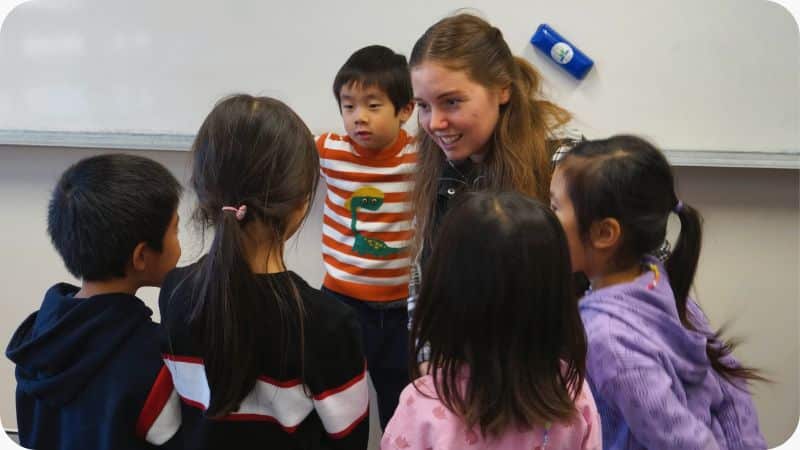
Want to find out more about all the benefits learning public speaking and debating can provide your child? Check out our blog to learn more!
Choosing the right class size for your child
When classes are too big, shy or introverted children may be hesitant to participate, which can limit their progress. That’s why it’s critical to enrol in a public speaking course or a debate club with a small student-to-instructor ratio. You’ll be surprised at how much your child will learn in a supportive environment where they feel comfortable taking risks. So, when choosing a public speaking class for kids, what are the reasons you should select a course with a small student-to-coach ratio?
1. Small class sizes allow for more one-on-one time with the instructor, which is especially beneficial for kids who are new to public speaking or debating
Small class sizes are ideal for beginners who are new to public speaking or debating. In a larger classroom setting, beginners may feel intimidated or nervous about speaking up in front of their peers. This can be the reason kids don’t feel confident while giving a speech at school, where class sizes often range from 25-35 students depending on the school.
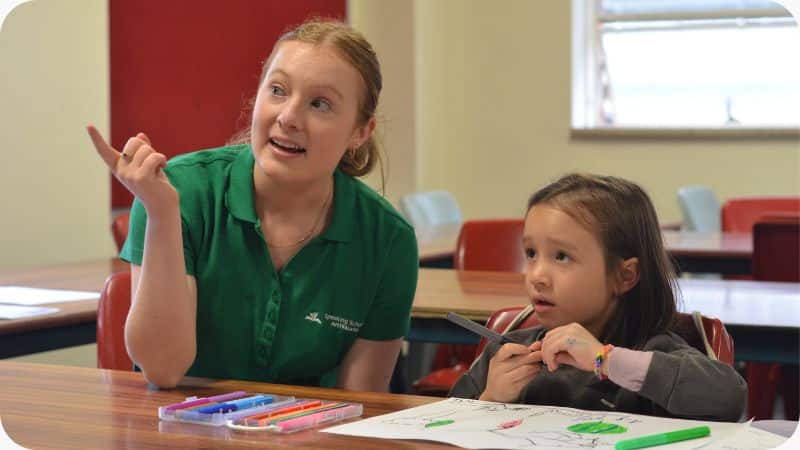
Check out our blog to learn more tips for giving an incredible speech!
Small classes are like training wheels for public speaking skills
The big benefit of learning debating and public speaking skills outside school is that your child can escape these overwhelming group environments. With a smaller class size, kids will have the opportunity to receive more one-on-one time with the instructor and get the personalized attention they need to build their public speaking skills, self-esteem and self-confidence.
Additionally, small class sizes create a more intimate and supportive learning environment, where beginners can feel comfortable taking risks and making mistakes. As they gain confidence in their presentation skills, they will be better prepared to take on the challenges of a larger classroom setting.
Learning to speak in front of a small class is like learning to ride a bicycle using training wheels. While it’s technically possible for a child to jump on a regular bike and have a go, they are far more likely to crash and have a traumatising experience that makes them never want to go bike riding again. It’s much more likely your child will enjoy public speaking if they have a chance to dip their toes in the water in a safe and supportive environment where they can build their communication skills, rather than being immediately thrown in the deep end with a big classroom full of students.
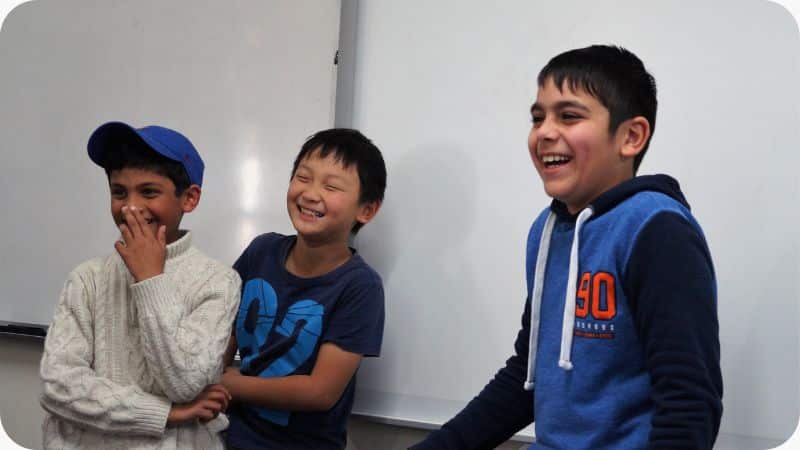
2. In a small class, students have more opportunities to participate in discussions and exercises, which helps them become more comfortable speaking in front of a group
In a small class setting, every student has a better opportunity to practice speaking in front of a group. More inclusion in class discussions and exercises helps kids become more comfortable with speaking up and also provides an opportunity to exercise active listening. This can make all the difference for young people who are shy or introverted.
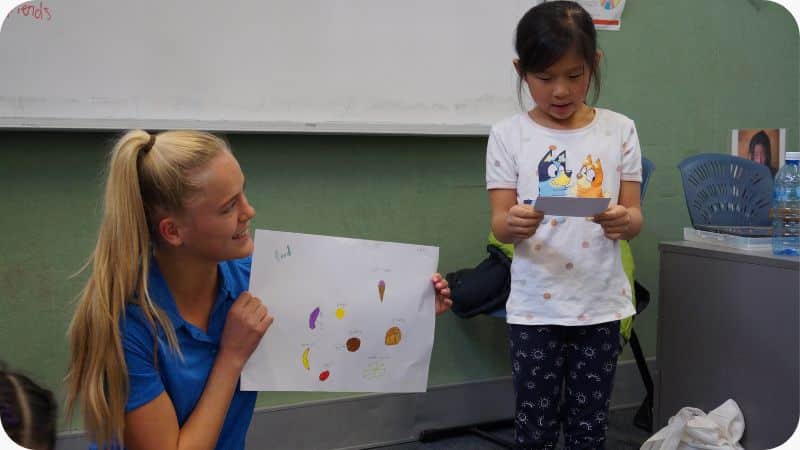
In smaller classes, everyone can have a turn (or two)!
Teaching children to speak confidently in engaging games and discussions during weekly classes allows them to perform better when the time comes to present their speech, as they have already been chosen to play fun games, answer questions, and be heard by the rest of the group.
Additionally, small classes provide a more inclusive environment where all kids can feel comfortable voicing their opinions and ideas. Ultimately, small classes provide a more supportive environment for kids to powerfully build their communication skills.
3. Students learn best when they are able to observe and interact with their classmates (and their teacher)
Interaction is key for kids to learn best. In a small class size, interaction with classmates is possible in every lesson. Being able to observe and interact with classmates allows for a more well-rounded learning experience as it exposes students to different perspectives and ideas.
Larger classes have fewer interaction opportunities, which can limit student learning. Intimate class sizes provide more interaction opportunities for working in small groups, engaging in class discussions, participating in games and receiving interaction and feedback from other classmates.
However, interaction is not only limited to classmates; it also includes interaction with the teacher. A good teacher will encourage interaction and make sure all students are engaged in the lesson. Therefore, interaction is crucial for kids to learn best and a small class size provides the most opportunities for this to occur.
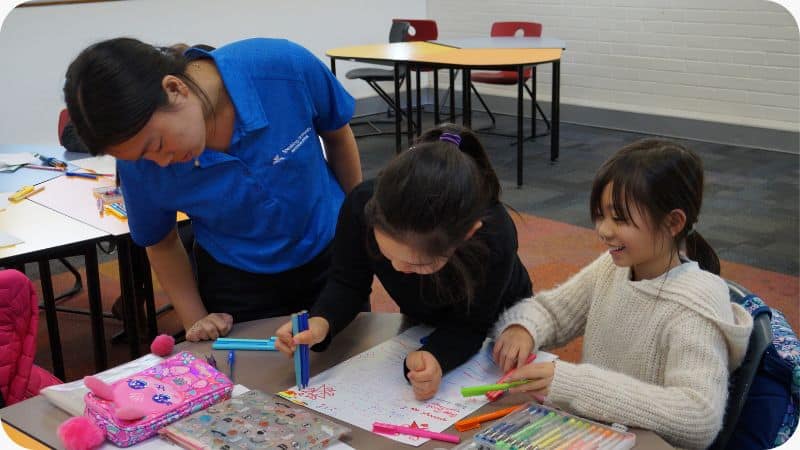
4. Instructors in small classes can give more individualised feedback and assistance to help each student reach their full potential
At Speaking Schools Australasia, keeping our classes small allows our teachers to fill out in-depth personal feedback sheets for every student at the end of the lesson, as well as provide them with feedback after each in-class activity that they can write down in their workbooks. This is beneficial because it allows kids to track their progress and see how they are improving over time as they learn how to communicate effectively.
Getting on a first-name basis
Additionally, small class sizes give instructors the opportunity to get to know each student on a personal level, which is important for providing individualised feedback and assistance. When teachers know their students well, they are able to better understand their strengths and weaknesses and tailor their instruction accordingly. Taking the strain off teachers that can be caused by large class sizes also enables them to have a high-energy and positive interaction with the children they are teaching public speaking. Regardless of the kids’ ages, having enthusiasm instilled by a teacher who has time for them can be a solid building block for their confidence.
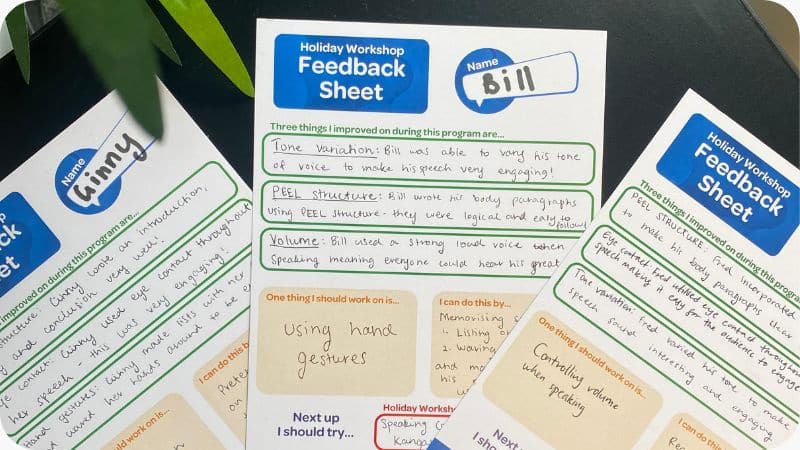
5. When all students are given the opportunity to speak and share their ideas, it fosters a sense of community and teamwork
When all kids are given the opportunity to speak and share their ideas, it fosters a sense of community and teamwork. It also allows for different viewpoints to be heard and for debate to take place in a respectful manner. If everyone is allowed to share their opinion, it lays the foundation for compromise and understanding.
When students feel like they are part of a community, they are more likely to take pride in their work and feel motivated to do their best. Furthermore, a cohesive team is more likely to be successful in collaborative activities like debating. Therefore, it is important that all kids have a chance to share their ideas and be part of the discussion.
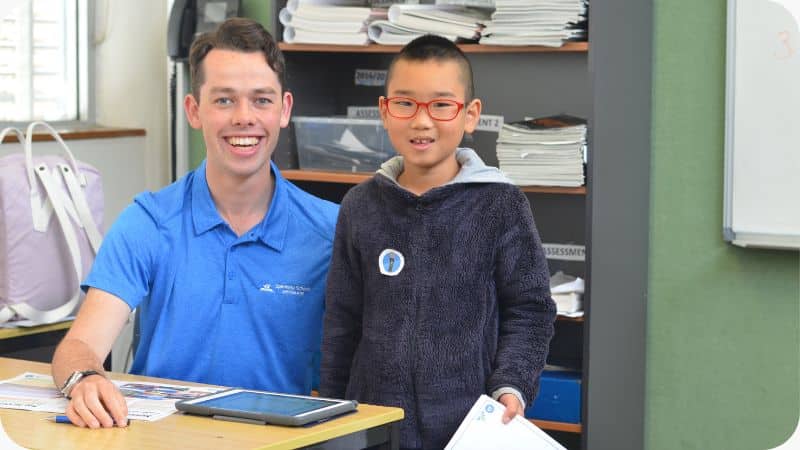
6. Students have the opportunity to ask questions and get help with manner techniques
Being in a smaller class has its perks–particularly for kids who want to get the most out of their manner training. When there are fewer students, teachers have the opportunity to give more individualised attention. This means that kids can ask questions and get immediate feedback on their vocal technique. As a result, they can learn at a pace that is comfortable for them and make progress more quickly.
In addition, instructors can provide coaching on how to use pace, pitch, pause, tone, and volume effectively to improve clarity and communication. For students who are serious about developing their speaking manner, being in a smaller class is definitely an advantage.
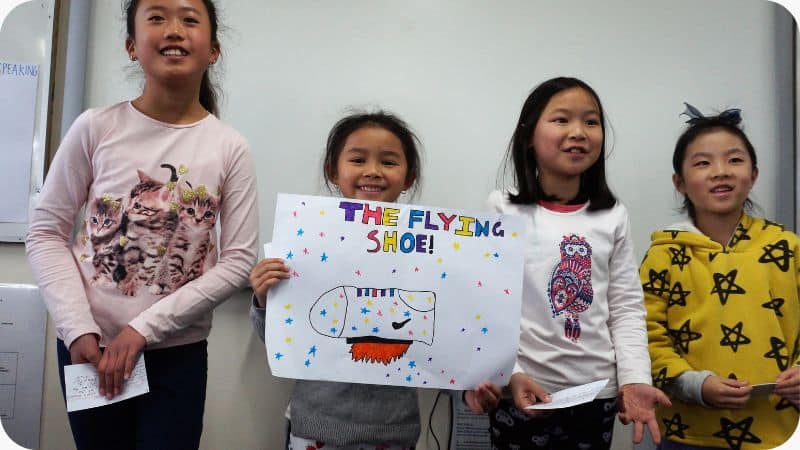
7. Smaller classes are kept fun and interesting with interactive exercises and games
Classes are kept fun and interesting with interactive games and activities which turn the class into a more student-centric environment. These exercises also help students to better retain information as they are actively engaged in the material, rather than passively listening. Games promote teamwork and communication skills, as well as life skills like problem-solving. They allow kids to use their imagination and be creative with their solutions. In addition, games provide an opportunity for laughter and lightheartedness, which is often lacking in more traditional classrooms. Ultimately, games can be a valuable tool in the classroom (and kids have so much fun playing them, they hardly realise they are learning skills with such enthusiasm)!
8. Small classes offer a more intimate learning environment where students can make friends
Everyone knows that feeling of stepping into a classroom for the first time where you don’t know anyone. It can be pretty daunting, especially if the class is large. But in a small class, everyone quickly becomes friends and it becomes much more comfortable to participate.
You’re not just a number in a small class, the teacher gets to know you and can help you if you’re struggling. You’re also more likely to make friends who share your interests. And if you’re ever feeling nervous about speaking up in front of the whole class, in a small group it’s easier to just share your ideas with a few people first. Small class sizes create a safe and calm environment where kids can relax and learn to their fullest potential.
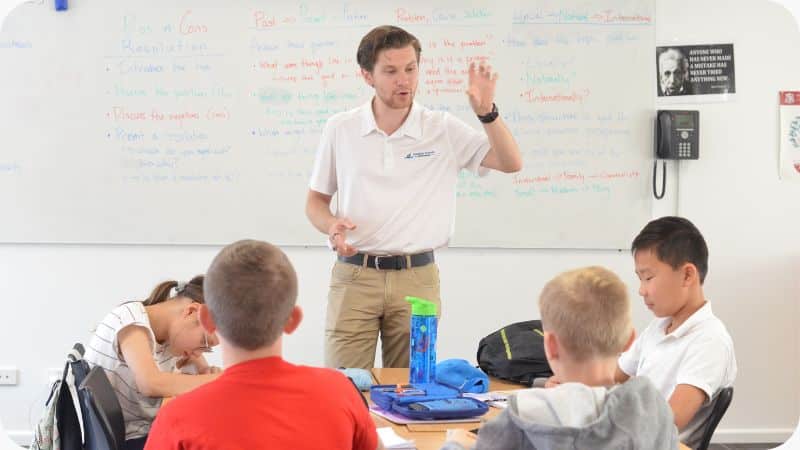
If you’re looking for a place that offers small class sizes for public speaking and debating, look no further than our programs at Speaking Schools Australasia. In our classes, kids have more one-on-one time with the instructor, giving them the opportunity to ask questions and get feedback. Our 1:9 student-to-teacher ratio is unparalleled in similar programs around Sydney and is carefully designed to maximise practical participation opportunities for all students.
They’ll be able to participate in discussions and exercises, which will help them become more comfortable speaking in front of a group. Our coaches can give more individualised feedback and assistance to help each student reach their full potential. Check out our wide variety of courses today, where you can find:
- Classes for kids that want to learn debating and public speaking
- Small class sizes for personalised learning
- Help your child become a confident speaker
- One of the best student-to-teacher ratios in Sydney
- Individual feedback
- Take-home feedback for parent review
- Student-centred learning
- Fun and engaging classroom environment
- Supportive way to build confidence
- In-person and online classes
- Weekly workshops or intensive holiday programs
- Public speaking courses that teach children valuable life skills
- Building confidence from a young age
- Develop skills such as speech writing, body language and eye contact
Why do students love debating and public speaking so much?
Though some may see debating and public speaking as nerve-wracking experiences, many students love participating in these activities. In fact, there are many advantages to debate and public speaking for students. By encouraging participation in these activities, through enrolling in a course or a school program, parents and educators can help students develop important skills that will last a lifetime.
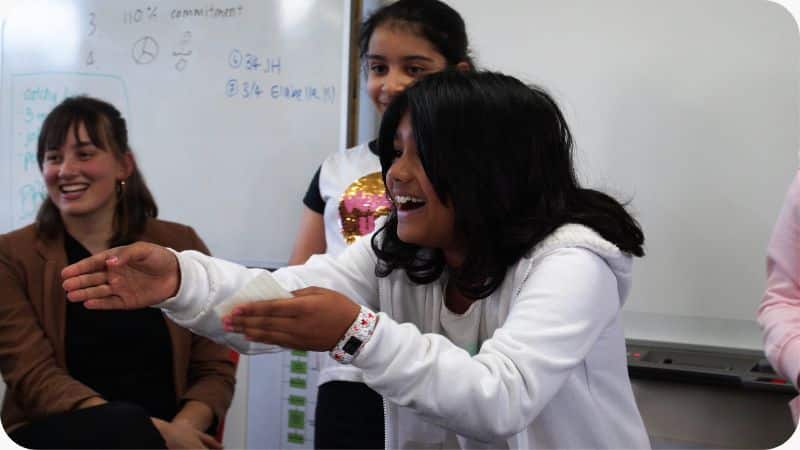
The surprising truth we learn from student feedback
At Speaking Schools Australasia, we work with thousands of students each year across various debating and public-speaking courses. With a strong focus on having fun and learning practical skills, we often see a lot of smiling faces in our programs. We run an in-depth survey with students who attend our programs. The resultant student feedback is a ‘guiding light’ for the many improvements we are constantly making to each unique program. The results we get are overwhelmingly positive, and shed light on the much-asked question: why do students love debating and public speaking so much?
If you, like many other parents we work with, grew up without learning public speaking skills in a fun and encouraging environment, the answers might surprise you.
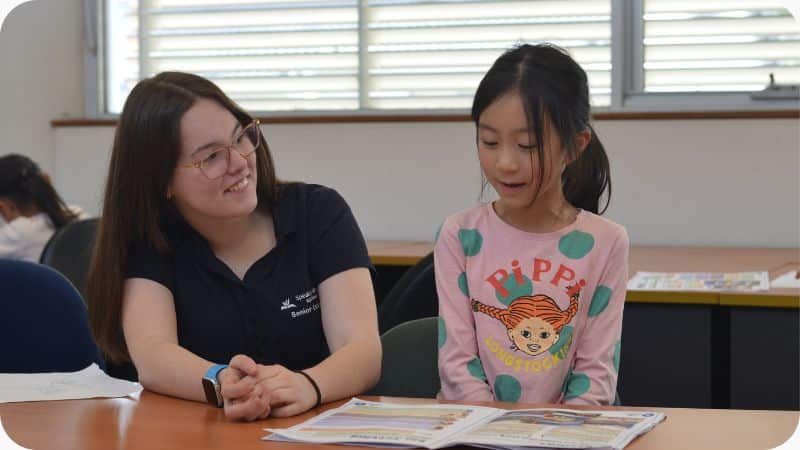
What are the benefits of engaging in debating and public speaking?
Confidence Boosting
Many students lack confidence, especially in front of large groups of people. Participating in a course about debate or public speaking can help students overcome this hurdle by gradually building up their confidence over time. Through real-life experience, they’ll learn how to project their voices, make eye contact, and speak with conviction—all important skills for success in school, university, and the workplace context.
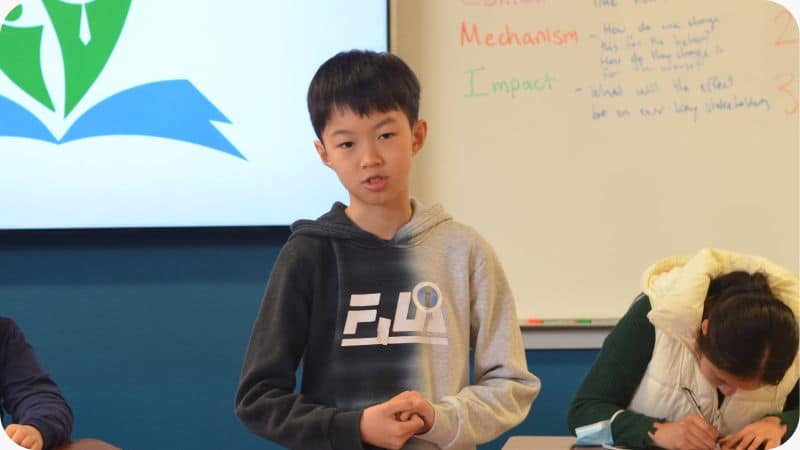
Thinking On Your Feet
When you’re in a debate, you can’t always take lots of time to consult your notes or think about your next argument—you have to be able to think on your feet and come up with a response on the spot. This is an extremely valuable skill that will come in handy in all aspects of life, from job interviews to difficult conversations with friends or family members. While the search for an argument or point on the spot can be difficult at times, it strengthens our ability to deliver arguments that contradict the other side of an issue at a moment’s notice.
Persuasive Writing
One of the key components of successful debating and public speaking is being able to write persuasive arguments that are easily understood. This involves doing extensive preparation on a topic so that you can anticipate your opponent’s arguments and counter them effectively. By honing their persuasive writing skills through debating, students will be better prepared for persuasive assignments such as essays and expositions.

While all of these advantages make sense to us, they are not always the reasons that students have such a great time learning the skills of debating and public speaking.
What did our students have to say?
We asked our Term #3 students how they really felt about debating and public speaking at SSA. The evidence we collected showed that the quality of education that our courses offer has been paying off for our young speakers. We measure the data and calculate the percentage of students who agree with certain statements in the survey. You can see some examples of the results from Term #3 below.
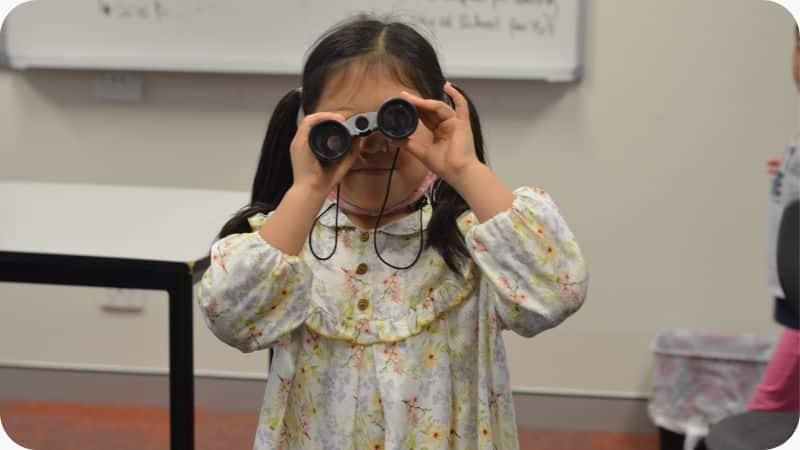
Did you enjoy the programs?
Over 95% of students said ‘YES’! This is a big part of why kids love these activities – speaking in front of an audience and sharing your opinions can be a lot of fun. In fact, when we frame debating and public speaking as an opportunity rather than a chore (as many schools, unfortunately, portray these skills), we notice a lot of students experiencing a new-found enjoyment while speaking in front of a group.
Do you feel more confident about debating/public speaking after completing the program?
100% of students said ‘YES’! This is an amazing result, and one we’re very proud of. We put a lot of emphasis on having fun while learning practical skills, so it’s great to know that this comes across in the way our students feel about themselves.
Do you think that you can structure your speech better now than when you started?
Over 95% of students said ‘YES’! This is another indication that our programs are successfully teaching students practical skills that they can use in their everyday lives. Learning structure can really demystify the task of writing a speech, allowing students to spend more time thinking about the fun things they want to talk about. This is true for debate speeches as well as public speaking.
Do you think that your speaking manner has improved?
Over 95% of students said ‘YES’! Speaking manner is how you speak. It encompasses elements such as pace, pitch, posture, hand gestures, and eye contact. Sometimes the reason students are not having a good time in debating and public speaking is because they perceive themselves as ‘bad’ at public speaking. Learning the elements of speaking manner and simple tricks to improve through our courses is often a huge confidence booster that makes speaking more fun.
Would you like to come back again and have another go next time?
Over 95% of students said ‘YES’! Nothing reveals how children feel about their extra-curricular activities as much as asking them whether they want to go back and do it all again. We’re thrilled that so many students want to come back and continue learning with us.

What would you say to someone who is thinking of joining a debating or public speaking program?
‘Just do it!’ was the overwhelming conclusion of our surveys. You are far more likely to have a great time in one of our courses than you might think.
Our students understand that the skills they’re learning are valuable and that the best way to learn is by getting out there and giving it a go.
We hope this gives you a better idea of what our debating and public speaking courses are all about, and why kids of all ages love them so much.
Debating and public speaking courses offer many advantages for students, from boosting confidence to teaching important life skills such as thinking on your feet and persuasive writing. If you’re looking for ways to help your child thrive both inside and outside the classroom, encourage them to participate in these activities!
Every year, tens of thousands of students across the country compete in public speaking competitions – think the Plain Speaking English Award, the Multicultural Perspectives Public Speaking Competition and Rostrum Voice of Youth, all of which are open to thousands of students each year – and these are only a small sample of what is out there!
Whilst these public speaking competitions can be nerve-wracking, they’re also a great way to hone your communication skills and build confidence. If you’re thinking of competing in a public speaking competition (or you’re being forced to do so by your school), here are a few tips on how to prepare.
Why should I participate in public speaking competitions?
There are lots of reasons why you should give public speaking competitions a shot!
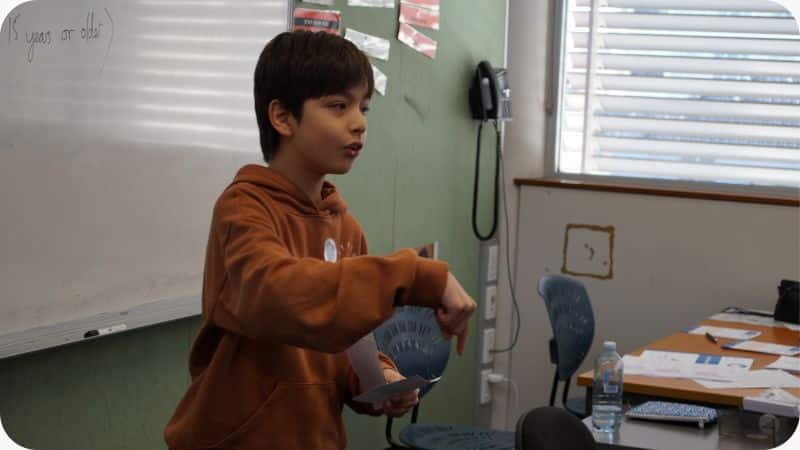
Want to learn more about the benefits of public speaking and debating? Check out our blog here!
Some reasons might include the following.
Boosts Confidence
One of the main reasons to participate in public speaking competitions is that it can help to boost your confidence.
When you stand up in front of an audience and deliver a speech – whether in a formal or informal context – you take incremental steps toward overcoming your fear of public speaking.
This can help to increase your confidence in other areas of your life as well, acting as even more useful personal development – if you’re able to confidently present to a larger audience, you’ll be able to use your presentation skills in other walks of life as well!
Improves Public Speaking Skills
Another reason to participate in public speaking competitions is that it can help to improve your public speaking skills by allowing you to present to a live audience. Whilst things like public speaking courses can definitely provide an audience, these are often small group classes – perfect for training public speaking skills, but no substitute for larger presentations.
When you compete, you are forced to push yourself and deliver a speech that is both better than those you’ve previously prepared, whilst also competing with others who could be professional speakers themselves.
This helps to improve your overall public speaking skills and makes you a more effective speaker.
Increases Knowledge
Participating in public speaking competitions can also help to increase your knowledge on various topics.
When researching for a competition, you are likely to come across new information that you were previously unaware of – not only can this be really interesting and great for your own personal development, but it can also help you develop a stronger understanding of new things on a deeper level.
This can help to make you more knowledgeable on the topic and also give you something new to talk about in future speeches – this is great public speaking training on its own merits, but also an excellent way to learn other new skills!
Helps You Meet New People
Public speaking competitions can also be a great way to meet new people.
When you compete, you will meet other people who are interested in (or, in some cases, scared of) public speaking.
This can help to expand your network and allow you to meet people from all over Australia and the world.
Gives You Recognition
Winning a public speaking competition can also give you the recognition that you deserve.
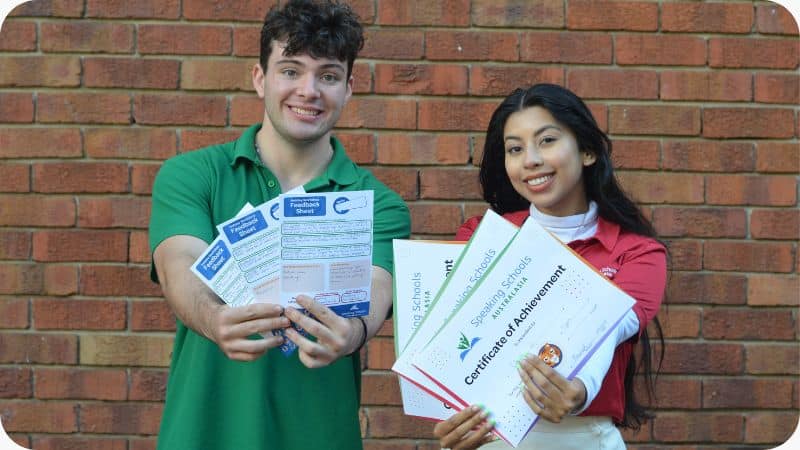
Whilst it’s great to learn new skills by participating in things like public speaking courses, such public speaking training is often limited to informal and non-competitive workshops – they’re necessary to boost your presentation skills, but this in and of itself may not be enough to distinguish you.
Once you’ve had an opportunity to receive some public speaking training, build up your confidence and overcome any fear around public speaking you may have, trying your hand at a competition can take things to the next level and may be able to help meet your own individual needs.
Presenting (and hopefully winning) at competitions can also be a great way of developing your skills and building up your resume too!
Sounds great – I’m in, but how should I prepare?
Whilst there are many ways you can generally prepare for a public speaking competition – from small group public speaking training to finding a course that helps boost your skills and confidence – below are some key points on how you may want to specifically prepare for your next competition (and you can find even more tips in our other blogs)!
1. Choose a topic you’re passionate about.
When it comes to public speaking, the most important thing is to be enthusiastic about your topic. If you’re not passionate about what you’re saying, it will be difficult to engage with your audience.
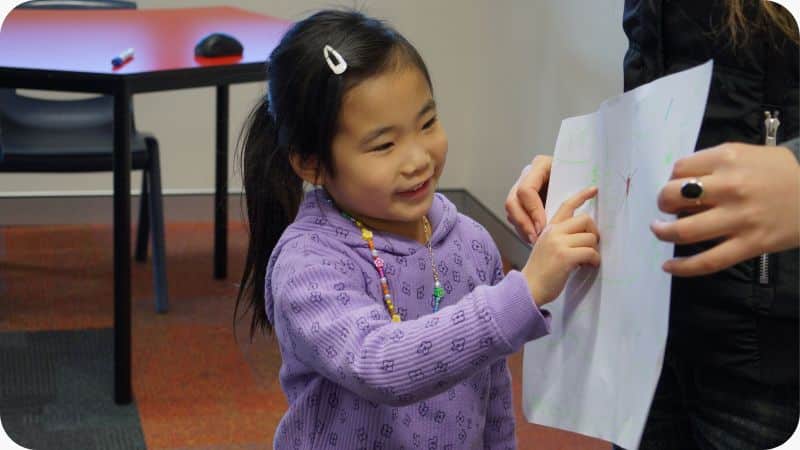
However, this can be more easily said than done – often for competitions we’re given a list of topics that we have to choose from, and in other tournaments a single topic that everyone needs to prepare for.
For example, in the Multicultural Perspectives Competition (which is put on annually by the Arts Unit), some topics used included “In my language”, “History matters” and “The power of sport”. But what should you do if you don’t speak another language, don’t know much about history and hate sport?
It’s important in these situations to ensure that you bend the topic to what you want to talk about.
Don’t speak another language? That’s okay! Language doesn’t need to be verbal – maybe you could talk about written or physical communication with others, or how everyone uses their own body language differently.
Don’t know much about history? That’s alright too! History refers to anything that’s happened in the past – maybe you could talk about why your own personal history matters, or even do a bit of research to learn more about how something modern came about.
Hate sport? Perfect! Talk about that – just because you’ve been given a topic doesn’t mean you need to agree with it. You can just as easily speak about how sport lacks the power others believe it holds.
Whatever you choose, make sure it’s something you care about and are knowledgeable about. If this means bending the topic to mean something a little bit different, that can in fact lead to an even more interesting presentation – your audience will likely be listening to a lot of speeches, so a little novelty can go a long way!
2. Know your audience.
Before you start preparing your speech, it’s important to think about who your audience is going to be.
Are you speaking to parents? Students? Teachers?
Knowing your audience will help you determine what kind of language to use and what points to focus on.
For example, if you’re speaking to a group of parents or teachers, you’ll want to focus on things that they care about and are interested in. This might involve using more formal language, and talking about things they can relate to, such as jobs they might hold.
On the other hand, if you’re speaking to other kids, you’ll probably want to use less formal language and relate your concepts to things they care about, such as study, sports or things that are happening around the school. You might even want to use a range of storytelling techniques to help communicate effectively!
Make sure you keep your audience in mind as you prepare your speech so that you can tailor it specifically for them.
3. Practice, practice, practice!
Once you’ve chosen a topic and know who your audience is, it’s time to start practising!
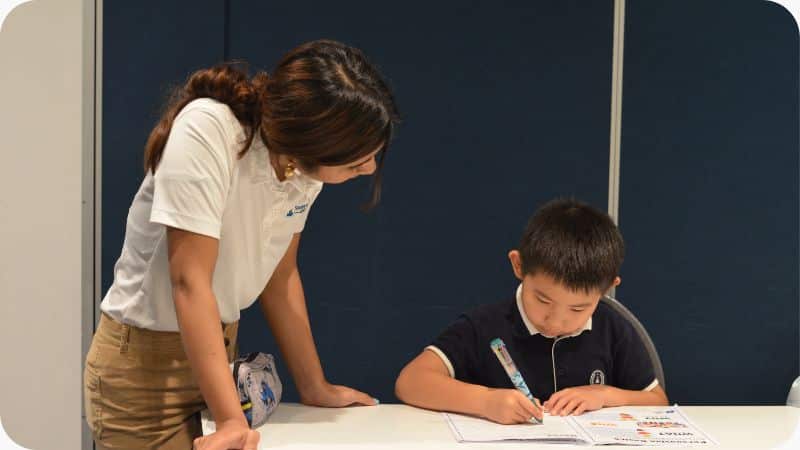
Any experienced public speaker will tell you that the key to delivering a great speech is practice. Not only do you need to know your material inside and out, but you also need to be comfortable with the way you’re delivering it. After all, if you’re feeling nervous or uncertain when you’re standing in front of an audience, that’s going to come through in your voice and body language.
The good news is that the more you practice, the more confident you’ll feel. So if you’re planning on giving a speech, make sure to set aside some time to rehearse. That way, when it comes time to deliver your speech, you’ll be able to focus on engaging with your audience and delivering your message, rather than worrying about whether or not you’re going to trip over your words.
One of the best ways to practice is by recording yourself on video. This way, you can listen back to yourself and identify any areas that need improvement – self-reflection is an excellent way to understand what you’re doing well and what might need some work.
You can also ask a friend or family member to listen to your speech and give feedback. This has the dual purpose of both getting some feedback on how you might be able to improve (such as eye contact or body language), as well as giving you some practical experience of speaking in front of an audience (albeit a smaller one than you’ll likely face in your competition!).
Practising as much as possible will help ensure that you’re prepared and confident on the day of the tournament.
4. Visualise success.
One final tip for those competing in a public speaking competition is to visualize success.
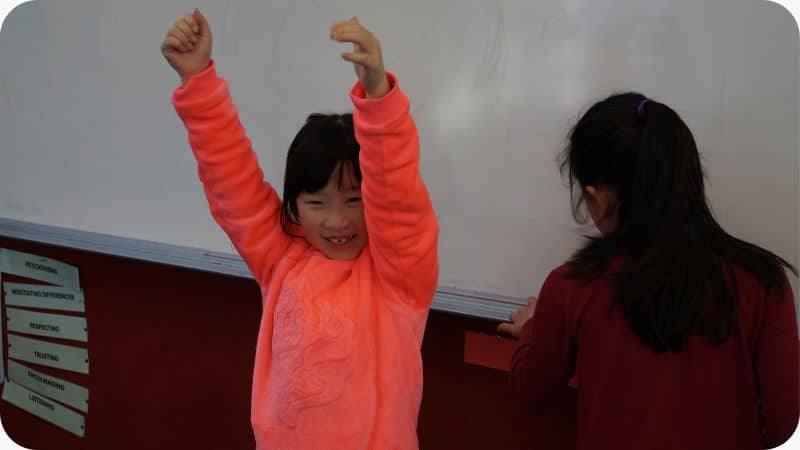
Picturing yourself delivering a winning speech will help increase your confidence and motivation levels.
When it comes time to compete, remember that visualisation techniques and picturing yourself giving an amazing speech.
With hard work and dedication, success is sure to follow!
How can Speaking Schools Australasia help?
If you’re feeling nervous about public speaking, don’t worry – you’re not alone. But by following these (hopefully) valuable tips and preparing well, you can give yourself the best chance of success in your next competition.
And if you need some help getting started, or are looking for a great course that meets your individual needs, our team at Speaking Schools Australasia are more than happy to assist – we are experts in public speaking training and can help students take their communication skills to the next level.
So what are you waiting for? Book one of our public speaking courses today and become a confident public speaker!
A summarised version of this blog first appeared on the Education Australia website.
The global pandemic has had a significant impact on confidence levels in children and young people. The sudden transition to online learning, without the opportunity to socialise with classmates, had been tough for many students.
At Speaking Schools Australasia, where we deal with over 500+ students each term, we had seen a resultant decline in confidence levels for some students, particularly when it comes to speaking up in class.
However, there are things that teachers can do to help their students regain confidence post-pandemic, which are still vital a few years out of Covid.
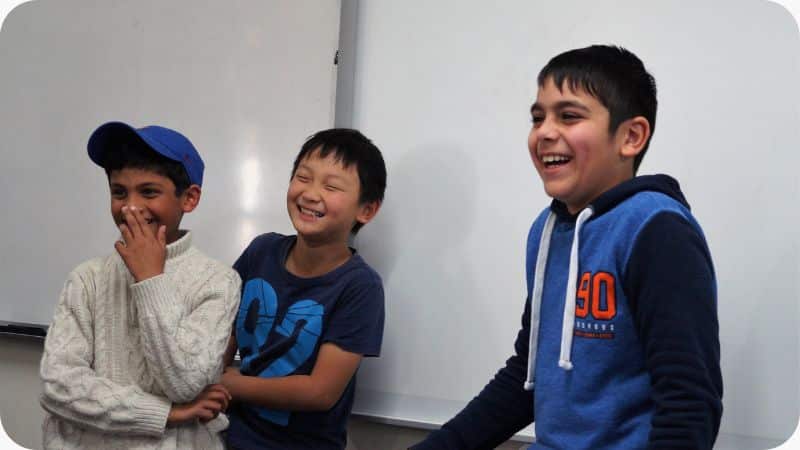
Why kids need incremental exposure to build up their speaking confidence
A big reason why confidence is low in the post-pandemic classroom is that it’s built through a process of incremental exposure. The more we do something, the more confidence we have in our ability to do it.
This is especially relevant when it comes to social confidence. If students are repeatedly put in situations where they feel uncomfortable or unsure, they will gradually become more confident in their ability to cope with these situations, building their resilience when dealing with novel circumstances.
This is especially true in social situations and presentations (both big and small), where a fear of failure can be compounded by the pressure of talking to a group.
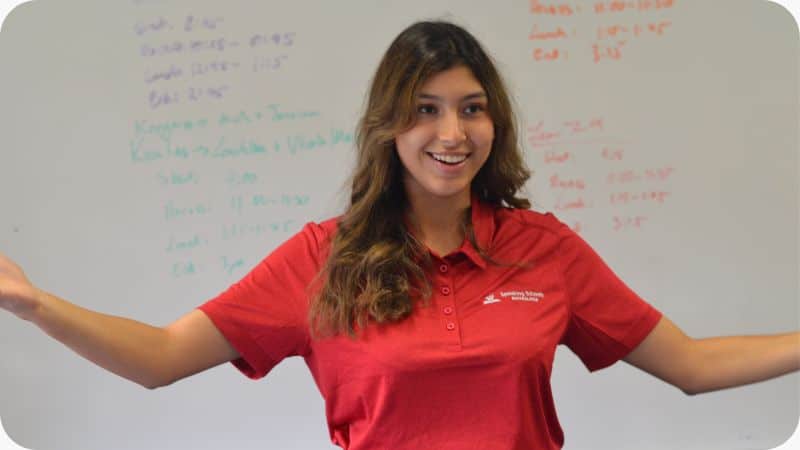
How live feedback from the audience helps to build a child’s speaking ability
One of the best ways to help students regain confidence post-pandemic is to provide opportunities for them to practice speaking in front of an audience. This doesn’t need to be a formal speech and could be a class presentation, group work, or even a simple curriculum-aligned discussion.
Live feedback from the audience is essential for helping students to develop their speaking ability and was sadly lacking when students were able to simply turn their cameras off in an online classroom.
Being able to see the facial cues, body language, and real-time responses of the class is an invaluable source of information that helps develop a child’s style of speaking.
This feedback can aid them in subconsciously identifying communication tactics that work well and building empathic instincts. Taken together, these can allow students to adjust their public speaking strategies according to the room they are in.
This skill builds both ways – practising being an audience member also builds public speaking confidence. When students practice active listening during presentations from their peers, they similarly gain a deeper understanding of communication strategies and what engages an audience.
Hearing from peers also helps to make education fun, allowing children to engage with each other and guide each other through the process of hands-on learning through trial and error together.
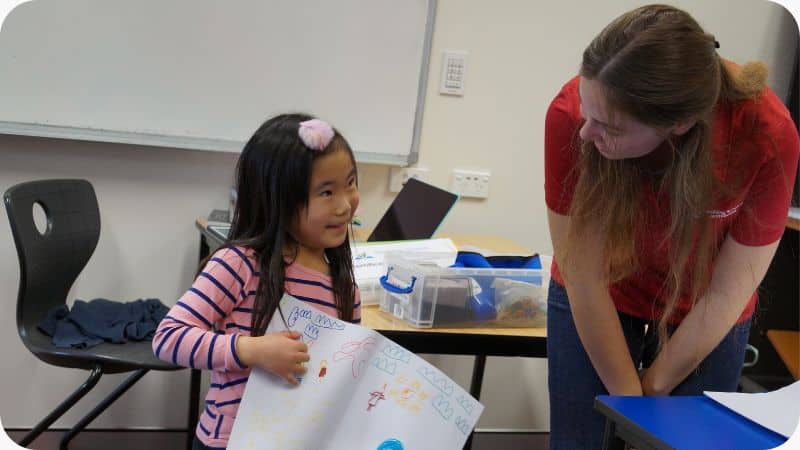
How can an educational public speaking and debating school incursion help?
Boosting self-confidence to deal with social anxiety concerns post-pandemic is essential for helping students thrive in the classroom. Teachers can help their students to regain confidence by providing opportunities for them to practice speaking in front of an audience.
We offer a range of different programs, seminars, and incursions that can help kids build their confidence when communicating with others, as well as workshops to equip teachers with everything they need to help bring out the best in their students. Making speaking up in class fun can genuinely transform a child’s confidence in the classroom.
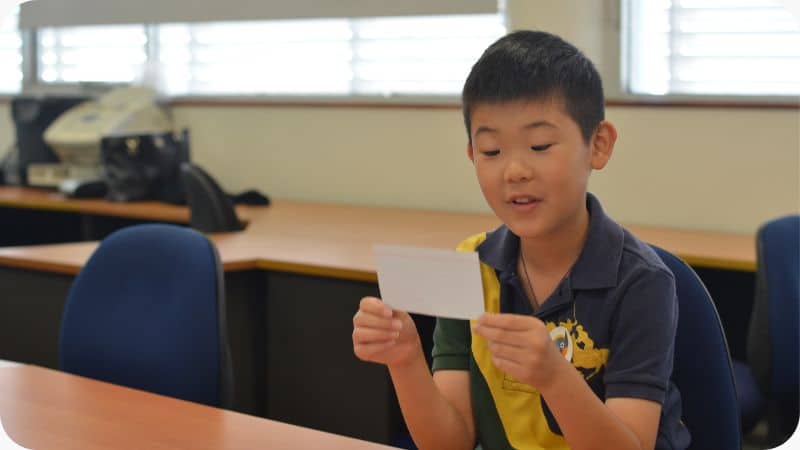
Skills-based workshops to inspire students
Debating and public speaking workshops are a great way to get kids inspired to build their confidence whilst having fun. These workshops are curriculum aligned and educational, but they also engage children in fun games that inspire them to be confident in themselves. By participating in these workshops, kids will learn how to think on their feet, how to communicate effectively, and how to build persuasive arguments.
These skills will help not only in the classroom but also in their everyday lives. As students gain more confidence in themselves, they will be more likely to take risks and try new things.
So if you’re looking for a way to inspire your students’ confidence, sign them up for a fun day of debating or public speaking with an engaging school camp, workshop or incursion!
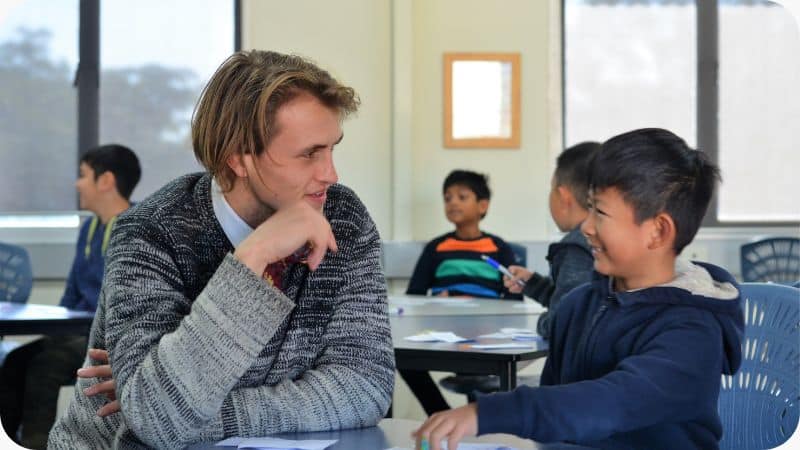
What are the pros of running a school incursion?
Incursions are a great option for teachers looking to expand their students’ skills and confidence. They offer a different way of learning that is both fun and engaging. Incursions are also relatively easy to organise, making them a convenient option for busy teachers.
Primary and secondary schools can both get involved, and there is a wide range of different workshops to choose from. This means that there is something to suit every class. Experienced coaches will work with the students for the day, providing them with the skills and confidence they need to succeed. This makes incursions an ideal way to improve student outcomes.
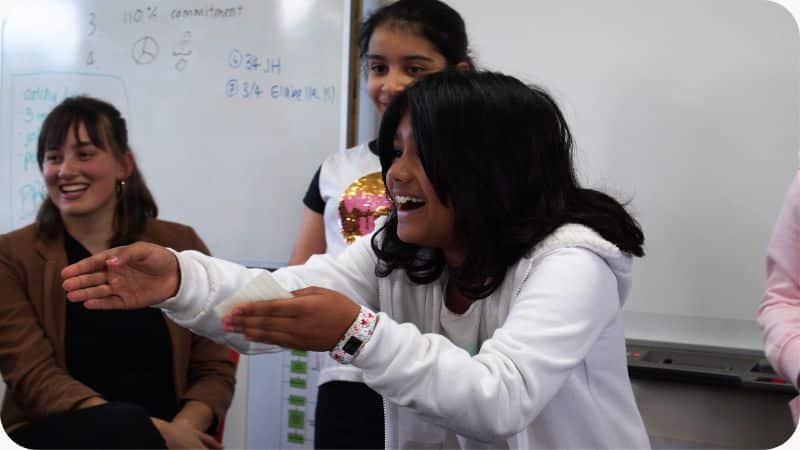
Why choose a debating or public speaking incursion?
There are many reasons why public speaking and debating skills are important for students’ futures. In particular, learning debating and public speaking can help students:
- develop critical thinking skills, where they learn how to take complex ideas and break them down into understandable arguments;
- Build their soft skills such as teamwork and communication.
- Develop their confidence and advocacy skills; and
- Finding their voice and assisting with their own character development as they grow up.
Teachers should consider these benefits when choosing an incursion for their students. Public speaking and debating offer a unique opportunity for students to gain the skills they need for success in the real world.
The Australian Curriculum does require students to learn some elements of public speaking – but often leaves educators in the dark as to the best way to do this. Often, there is a lot of flexibility between schools’ approaches to public speaking and debating. This is due to the Australian Curriculum leaving a lot of elements of how we approach public speaking education largely up to the school or individual teacher. When nobody within a school community is empowered with knowledge or experience in teaching debating and public speaking, the future generation can be deprived of learning some of life’s most important skills.
Educational speaking workshops are an excellent way to fill this gap in the Australian Curriculum at your school. A program in debating or public speaking can be transformative not only for the class but also for the teacher looking after them.

One of the biggest things that an incursion can offer your school is that it makes public speaking and debating fun. Children are in a formative stage when they try speaking in front of a group for the first time. Our aim is to make this formative experience as exciting and fun as possible.
Associating debating and public speaking with fun can be absolutely transformative for children’s confidence. Often, they start to see the task of speaking in a different way and avoid developing fearful associations and phobias of presenting to a group. Getting children involved in exciting, fun, educational programs and school incursions can make a world of difference to their attitudes towards public speaking. Many students become very passionate about improving their speaking ability and discover the importance of finding the courage to speak up in front of a group.
What makes school incursions with SSA Different?
With our belief that every child deserves the opportunity to find their voice and be empowered, we provide students with fun environments where they can develop skills necessary for success. We focus on developing critical thinking whilst encouraging communication through debating or public speaking classes in order to give children confidence and build up resilience as well!
Here at SSA, we believe that every child has the potential to be a great public speaker and debater. That’s why we offer a range of programs designed to develop these skills in kids of all ages. Our incursion programs are a great way to give kids a taste of what public speaking and debating are all about. It’s also lots of fun!
We tailor our programs to suit the needs of your school, so whether you’re interested in a one-off workshop or an ongoing series of classes, we can accommodate your needs and the needs of your students. We’re confident that your kids will love learning with us, and we hope that they’ll be inspired to use their new skills in exciting and innovative ways.
As experts in public speaking and debating who have taught over 15,000+ students both locally and abroad, SSA is perfectly placed to run a memorable, exciting and inspiring incursion in your school.
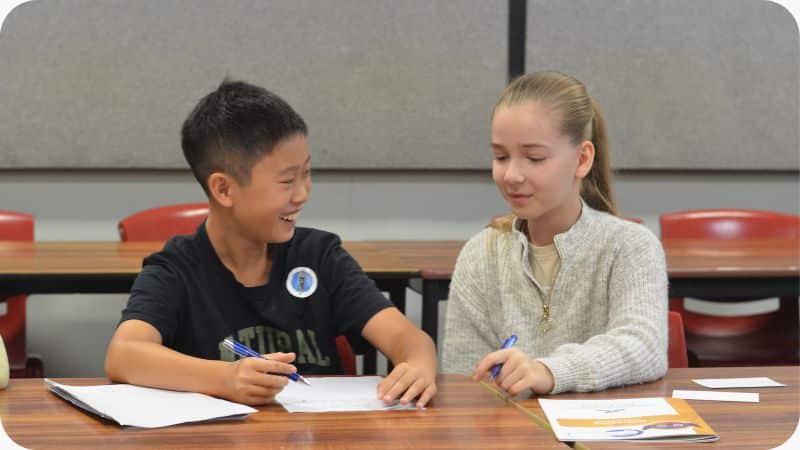
School Incursions – Sydney and New South Wales
Are you looking for a school incursion or for school activities based in Sydney and greater New South Wales? We can help you out! We are passionate about bringing speaking education to the next generation all around Sydney and the rest of New South Wales.
Every school’s needs are different – whether you are looking for an online option your students can participate in via Zoom, or for engaging school incursions in-person, we pride ourselves on creating interactive events that are well suited to each individual school.
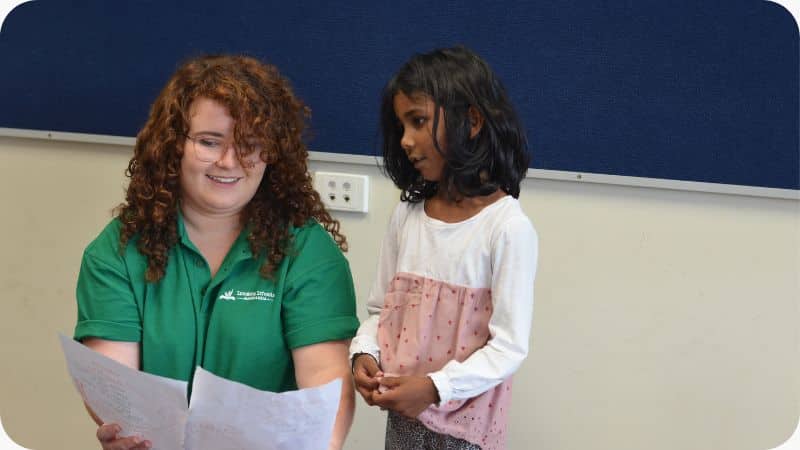
What can you expect from an SSA School Incursion?
- Hands-on learning
- Hands-on activities
- Learning fun
- A fun day designed to inspire children
- A unique experience in building speaking confidence
- Creative games to play
- Engaging and interactive content modules
- Team building activities
- Opportunities for students to build creativity and imagination
- Tailored programs and workshop options
- Events that suit all ages
- Developed to suit a variety of school and class sizes
If you’d like to find out more about what we do, please don’t hesitate to get in touch, or visit our School Incursions page to learn more!
Last Updated on 4 September 2024
Speaking Schools Australasia (‘SSA‘) is committed to providing a quality service for all organisational stakeholders.
This post summarises the key points of the SSA Credits & Refunds Policy (last updated on 4 September 2024).
Please reach out should you like a copy of the complete Policy to which this post refers.
Definitions
For the avoidance of doubt:
- ‘Credits’ refer to monetary amounts which can be claimed for future programs and are usually stored as ‘Vouchers’ on the SSA website;
- ‘Refunds’ refer to monetary amounts that are returned to the person who paid for a service, usually through the same method that they initially used to pay; and
- ‘Replacement Sessions’ refer to any classes taken in lieu of what was originally booked.
Replacement Sessions
Replacement sessions may be offered where:
- A student is unable to make a session that they are enrolled in; and
- The student and/or parent alert us to their absence in advance of the session.
Given regular attendance is important for continual development, a preference is given for students to attend replacement sessions where possible.
Special Considerations: Holiday Workshops
Replacement sessions for holiday workshops generally involve inviting the student to attend the same (or similar) program on other dates (and potentially at another venue).
Replacement sessions may be offered for single days of holiday workshops.
Special Considerations: Term Programs
Replacement sessions may be issued for complete sessions of a term program, but are not generally issued for part-sessions.
Unless approved by a relevant SSA team member, only one credit or two replacement sessions can be issued per student, per term. This will be decided on a case by case basis, and will have regard to:
- The reason for the additional requested credit/replacement session;
- The number of credits and/or replacement Sessions previously given;
- The number of classes the student has completed with SSA; and
- Any other consideration deemed pertinent by the decision maker.
Special Considerations: Private Coaching
Generally, replacement sessions for private coaching:
- can only occur for up to 25% of scheduled sessions (e.g. if there are 8 sessions, only 2 may be rescheduled);
- must either have 72 hours notice or, where this is not possible (e.g. sudden illness), as much notice as practicable to both the coach and the relevant Franchisor; and
- must be arranged between the parent and the coach to ensure that they meet the coach’s schedule.
Generally, unless there are exceptional circumstances, all private coaching sessions that a student does not attend are either rescheduled as replacement sessions or forfeited.
For clarity, the above does not prevent the arranged usual time for the private coaching sessions from being rescheduled (e.g. Thursday, 4:30pm, no longer suits one party, so the parent and coach arrange to move all future sessions to Friday, 5:30pm).
Issuing Credits
Generally
Generally, SSA will issue credits to parents of students who:
- Are unable to attend a session they have paid for due to a good reason; and
- Raise this with us in advance of the session.
Good reasons for a credit may include (but are not limited to):
- The student is unwell;
- The student is on holiday;
- The student has another important commitment (e.g. school camp, one-off competitions etc.);
- The student has moved home and can no longer attend the classes; and
- Where SSA or its representatives have made an error, and the credit is offered as part of compensation for that error.
If available, SSA will generally offer alternative replacement sessions as a first preference in lieu of a credit.
Special Considerations: Holiday Workshops
Credits may be issued for whole days of holiday workshops but are not generally issued for part-days.
Special Considerations: Term Programs
Credits may be issued for complete sessions of a term program but are not generally issued for part sessions (unless that part session resulted from SSA’s error).
Unless special circumstances apply, only one credit or two replacement sessions can be issued per student, per term. This will be decided on a case-by-case basis, and will have regard to the following:
- The reason for the additional requested credit/replacement session;
- The number of credits and/or replacement Sessions previously given;
- The number of classes the student has completed with SSA; and
- Any other consideration deemed pertinent by the decision maker.
Special Considerations: Extensions
Extensions to credits may be offered on a case-by-case basis but will generally not extend past Week #6 of the following term.
Issuing Refunds
Generally
Generally, SSA will issue refunds to parents of students who:
- Are unable to attend a session they have paid for due to a good reason;
- Raise this with us in advance of the session;
- Have not found alternative options (such as a replacement session or credit) to be sufficient; and
- Have been approved for a refund by a relevant General Manager.
Good reasons for a refund may include (but are not limited to):
- The student and/or parent is unhappy with the program;
- There was an incident during a class that substantially impacted the student;
- The student has moved home and is no longer able to attend the class; and
- SSA made changes to the class that impacted the student (e.g. cancellation).
If the reason for the refund is that the student and/or parent is unhappy with the program or that an incident occurred that substantially impacted the student, the relevant member of the SSA team will reach out to them to discuss the issues before a refund is approved.
Special Considerations: Holiday Workshops
Refunds may be issued for whole days of holiday workshops with the approval of the relevant SSA team member, but are not generally issued for part-days.
Special Considerations: Term Programs
Refunds may be issued for complete sessions of a term program with the approval of the relevant SSA team member, but are not generally issued for part sessions.
Special Considerations: Transaction Fees
Where a refund is issued for more than 50% of a booking fee where SSA paid a transaction fee, and SSA is not at fault for the refund being issued, that transaction fee may be deducted from the refund.
Any deduction for a transaction fee must be in the same proportion as the refund it relates to (e.g. if 60% of the booking fee is being refunded, SSA may only deduct 60% of the transaction fee from the refund).
Abusive Conduct
SSA will generally not offer credits or refunds to parents who have engaged in abusive behaviour unless required to do so under the Australian Consumer Law.
On Saturday evening, our management team had the wonderful opportunity to attend the 2022 Small Business Champion Awards at the Star, Sydney. We had a wonderful evening celebrating our team’s hard work and accomplishments over the past year.
None of it would be possible without the amazing community of parents and students we are privileged to work with every day. Thank you for being a part of SSA’s journey as a small business.
Whilst we didn’t walk away with any awards, we are super proud of our team for their hard work and ingenuity throughout 2022. There were thousands of entrants who didn’t end up as finalists – it is a genuine achievement that Speaking Schools Australasia got there, and a testament to what we’ve achieved over what was an incredibly trying year.

Pictured (left to right): Tennyson Brazier (GM – Corporate & Holiday Operations), Rani Ravinthran (Community Manager), Mark Slaven (Managing Director), Marianne Parackal (GM – Strategy & Term Operations), Anna Gonzalez (Community Manager), Isabelle Joyce (Senior Coach).
What are the Small Business Champion Awards?
Australia’s most outstanding small businesses are recognised with the Australian Small Business Champion Awards. These prestigious and comprehensive awards offer an opportunity to highlight Australia’s hard work in generating employment for millions of Australians, as well their contribution to our economy.
Since its inception in 1999, the Australian Small Business Champion Awards have recognised and rewarded excellence for small businesses across all states. More than just a plaque or certificate given at an event – this program is about celebrating those who excel as Australia’s most successful entrepreneurs and small business owners.
The event itself had appearances from the NSW Premier, a foreword written by the Prime Minister and awards presented by a range of State and Federal MPs.
Check out a full list of this year’s winners here.
What was SSA recognised for?
SSA was a finalist for excellence in our business outline, features and achievements. This included our strong promotion, top-quality products and customer service as well as success over the past two years. We were recognised for managing and monitoring customer satisfaction extremely well.
It was a great opportunity to celebrate the successes of small businesses from across Australia, and we were so proud to be recognised as finalists in the “Children’s Educational Services” category.
The night was also a beautiful moment to meet other people with like-minded goals and showed us how enthusiastic people can be about having an impact on the future of students learning. Helping to guide the next generations to be more confident and to help them achieve success.
This instilled confidence in our team that despite the challenges of the last few years not only are we doing the right thing and the impact is being recognised, but also that we are part of a larger community working to help students develop holistically.
Check out the photos from the night:



By Chris Giacoumakis
An enriching cultural phenomenon that deserves to be acknowledged, appreciated and embraced.
For millennia, storytelling has been fundamental in connecting people, preserving cultures, customs & traditions, and enriching our existence. Our ancestors used it as a way to not only pass down cultural and moral directives but to build community and strengthen the tapestry weaving its way across generations.
In Australia, we are enriched by a beautiful and long-standing Indigenous culture that perfectly showcases the pivotal role storytelling plays. In Indigenous cultures, there are hundreds of languages which are connected to a particular country that uses them. Within this complex system of languages, the role of storytelling was and continues to be the way to preserve language, culture and customs as well as strengthen bonds between elders and their descendants; subsequently reinforcing a sense of belonging and identity.
Stories often do this – they gift us with a reason, with a sense of affiliation, and can often take on the role of a guiding hand in our ethical and moral choices, as well as entertaining us. Consider Aesop’s’ fables – Aesop, the Ancient Greek fabulist, had a wonderful gift of telling stories that at first glance were perceived to be simple, yet carried with them a pertinent moral code used to enlighten young and old minds alike.
In some cultures, storytellers are of noble distinction and therefore are highly respected. Take some parts of West African culture where their storytellers were known as ‘griots’. These storytellers were also gifted in the areas of counselling royalty, revered as apt historians and ambassadors. There were even schools where one could train to pursue the profession of a griot!
Words, as effective and excellent as they are in narrating a story, are not the sole way to engage in this art form; the body can also be an instrument of narration. Just like our own Indigenous Australians, the Hawaiian and Indian cultures also use dance as a way to also share stories. The famous Hula is a prime example of storytelling through the art of language and dance combined. Indian temple dancers, or devadasis, perform Bharatanatyam, a spiritual dance that takes on the role of telling intricate and stories about gods/goddesses, such as Krishna or Shiva.
Storytelling can also help us heal and can inspire us. We can often find comfort when we resonate with someone else’s journey and their subsequent uprising, bolstering our evanescent faith and reminding us that all will be well. And most importantly, stories teach us to be great listeners.
Take a moment to pause and reflect. How many stories have impacted your life, whether as a child or as an adult or both? How many stories have helped you out of darkness, have helped you find a sense of direction, an escape, or have bestowed you with the gift of a good ol’ belly laugh? Stories are our friends, our allies, and our most heavily underrated cultural and communication tool.
We at SSA value the art of storytelling that we have integrated into our program offerings – check out our website for more details, or drop us a line at contact@speakingschools.com.au.
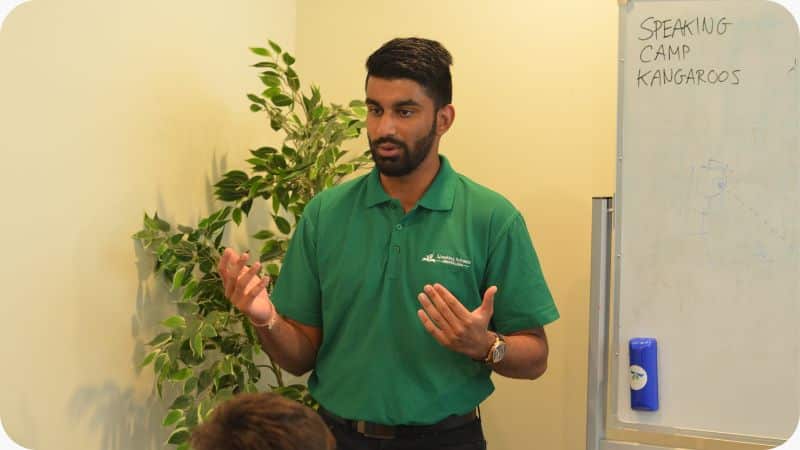
Giving a speech can be daunting, especially if you’re not used to public speaking. But don’t worry! With a little practice and these 11 tips, you’ll be delivering speeches like a pro in no time.
1. Start with a strong opening
Find your hook
So how do you make sure you give a great speech? Start with a strong opening.
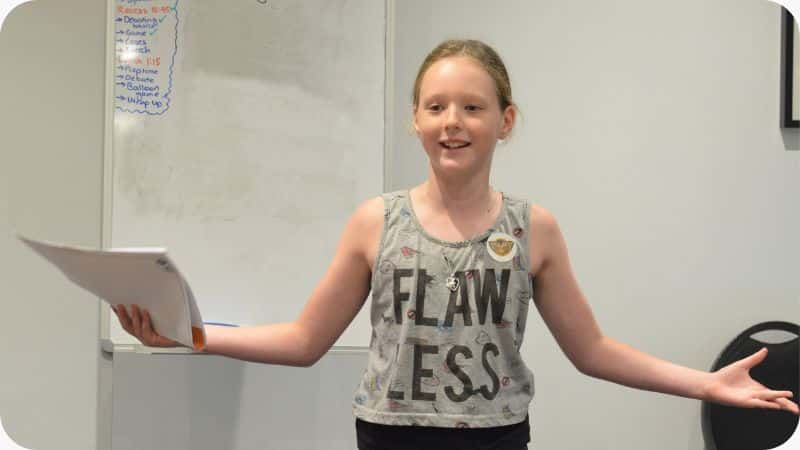
This is your chance to make a great first impression and grab your audience’s attention from the get-go. Start with something shocking, humorous, or simply fascinating to hook your listeners in and keep them engaged throughout your entire talk. With a strong opening, you’ll set the stage for a captivating and successful delivery.
2. Keep it simple
Don’t try to cram too much information into your speech. Stick to one central message and build your talk around that. If you try to cover too many topics, you’ll only end up confusing your audience and muddling your main point.
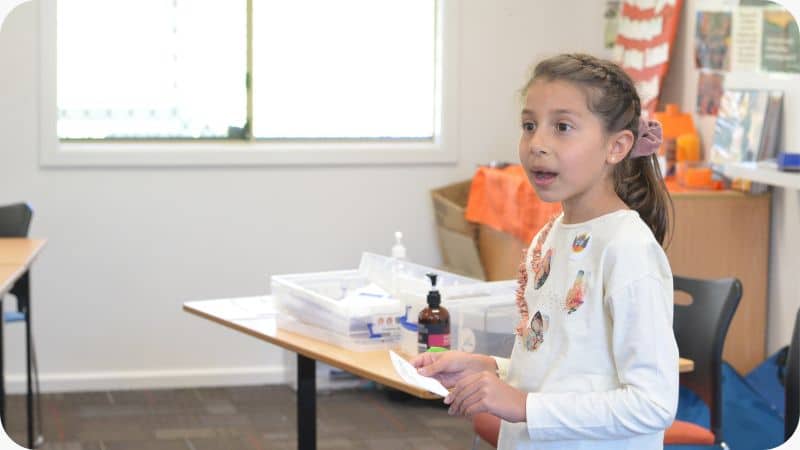
Anyone who has ever given a speech knows that public speaking can be nerve-wracking. One way to ease your anxiety is to keep your speech simple. A well-organised, straightforward speech is easier for the audience to follow, and it makes a more powerful impact than a meandering one.
One trick for keeping your content simple is ‘the rule of 3’s’. Information is generally more interesting in groups of 3, and it can be best to keep groups of adjectives, lists of items, and other parts of the speech in groups of 3. That will keep things clear, calm, and collected (see what we did there with a group of three adjectives?)
How can you simplify your talk?
Of course, delivering a simple speech is not always easy. It requires confident public speaking skills and the ability to distil complex ideas into their essence. If you find yourself struggling with public speaking, there are many resources available to help you hone your skills, including public speaking courses and communication training.
And if you’re looking to give your kids a head start, there are even public speaking skills courses explicitly designed for kids. With a little practice, you’ll be able to deliver simple speeches that are both effective and impactful.
3. Make it personal
Your speech will be more effective if you can connect with your audience on a personal level. Share stories and examples that they can relate to, and avoid using jargon or industry-specific language that they may not be familiar with.
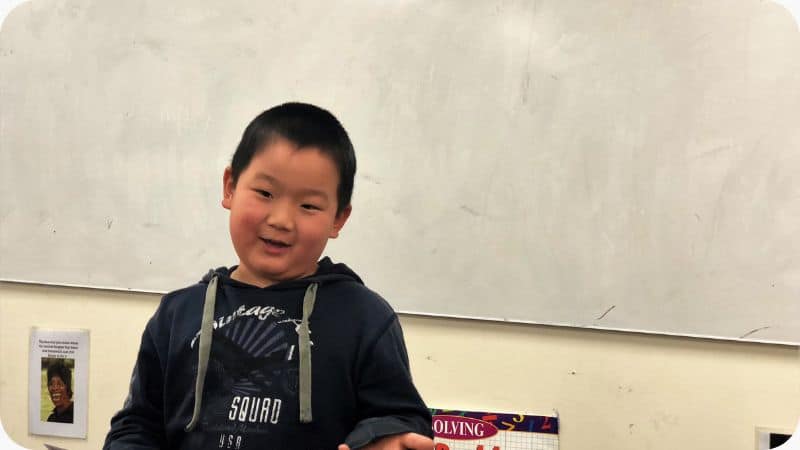
The best presentations are relatable
Connecting on a personal level will make your speech more effective and engaging. There are a few ways to do this. First, focus on speaking, not just talking. Make sure you’re speaking clearly and confidently. Second, tell a story that your audience can relate to. This will help them feel connected to you and your message. Third, lead by example. If you’re passionate about what you’re saying, your audience will be passionate too. Finally, be natural. Don’t try to force anything, just let your personality shine through. If you keep these things in mind, you’ll be able to connect with your audience and enhance your communication skills.
The balance between facts and fiction
One of the most effective tips is to focus on stories rather than facts and figures. When you lead with a story, it helps to create a more natural connection with your audience and enhances your credibility as a speaker. It also helps to focus their attention on what you’re saying. Of course, this doesn’t mean that you should completely neglect facts and figures – they can still play an important role in your speech. However, including a personal story or two can make a big difference in how effectively you connect with your audience.
4. Be passionate
Few things are as inspiring as a passionate speaker.
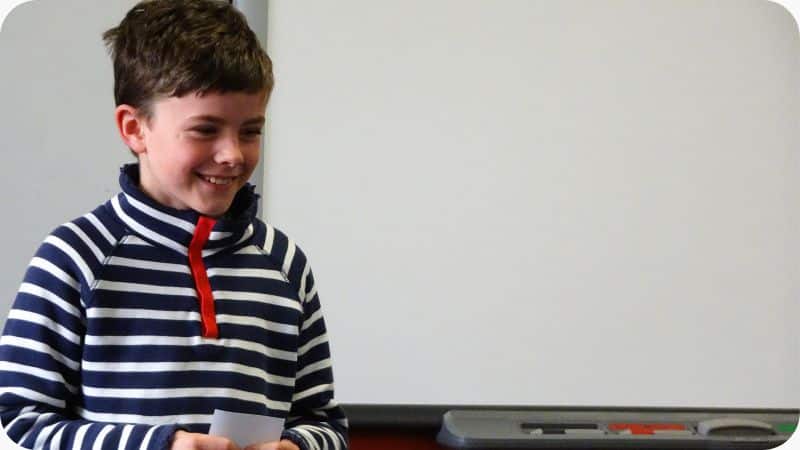
When someone is truly passionate about their subject, it comes through in their voice and their words. They make you feel like you’re part of something bigger and that together, success is possible. Passionate speakers also have a way of making you feel like your career or life could be so much more than it is. They inspire you to take risks and to believe in yourself. And finally, passionate speakers have a sense of calm about them. They exude confidence because they know that they’re talking about something they’re truly passionate about. So if you want to give an incredible speech, be passionate. It makes all the difference.
Crowds love stories, and a person they can relate to
When you’re passionate about something, it shows–and your audience will be inspired by your energy and enthusiasm. Remember that a great speech is about joining with your audience, not lecturing them. Try to find common ground and build a sense of connection. Finally, don’t be afraid to share your own experiences of success and setbacks. Giving a speech is an opportunity to show others that you’re just like them–and that’s what will make them want to listen to you and join you on your journey. With these tips in mind, you’re well on your way to giving an incredible speech that will leave a lasting impression.
5. Use strong visuals
Use PowerPoint slides or other visuals to help illustrate your points and make them easier for your listeners to understand.
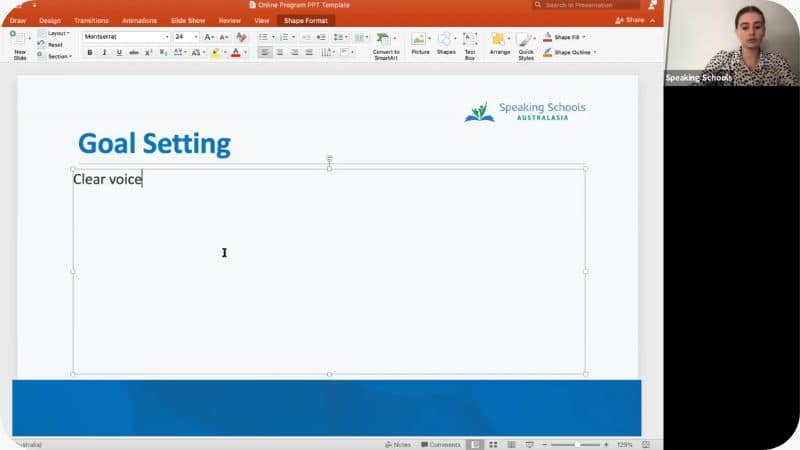
Avoid using too many text-heavy slides, as they can be difficult to read and follow.
Think about your body language
If props and visual aids are allowed, make sure that you stand in a position that doesn’t block the slides, but also calls attention to you as a speaker. It can be useful to move around and to interact directly with the visual aid the group is watching.
6. Practise, practise, practise
The more you rehearse, the more confident you’ll feel when it’s time to deliver your speech.
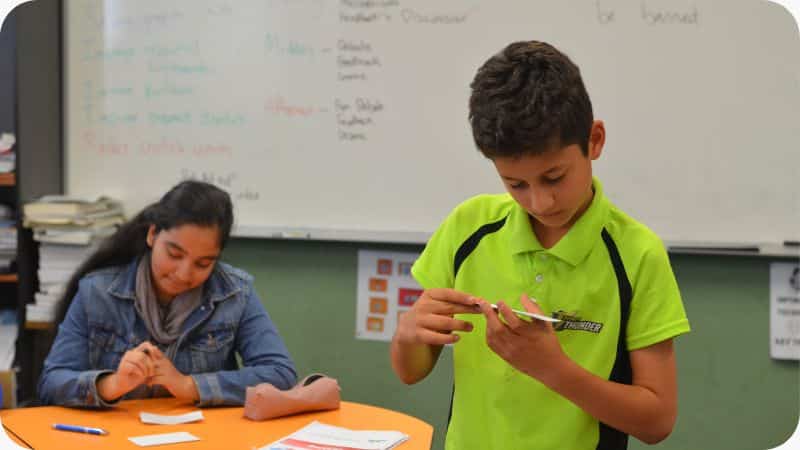
Practise in front of a mirror, or even better, video yourself so that you can see how your presentation comes across. Are you looking up for several seconds at a time? Are you showing signs of anxiety or nerves? How attention-grabbing is the beginning of the speech? When we prepare a presentation we are engineering a performance. Crowds will always be grateful to watch an active and well-rehearsed performance that has taken some feedback (even self-administered feedback) into account.
You can learn more about the benefits of practising properly in our other blogs!
7. Speak slowly and clearly
When we get nervous, we tend to speak quickly and our words start to run together.
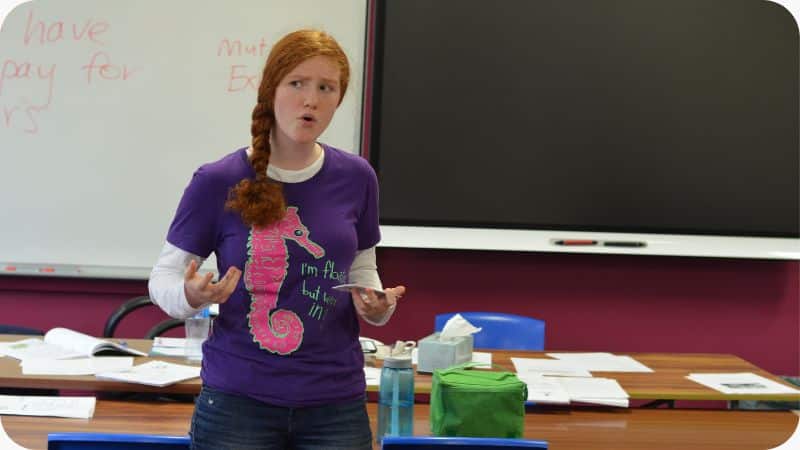
Slow down and enunciate each word clearly to ensure that your audience can understand you. Pausing briefly between thoughts can also help to keep your listeners engaged.
8. Project your voice
If you’re speaking in a large room, make sure that your voice is loud enough to reach the back row.
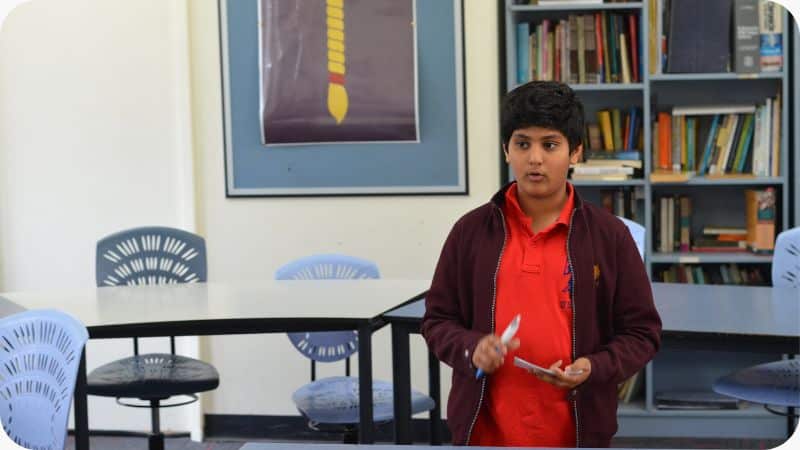
Practise projecting your voice without sounding like you’re shouting, and avoid mumbling or using filler words like “um” or “like.” Even if you’re feeling nervous, the most important thing is to make sure your speech is audible. In fact, it is better to speak unnaturally loud while presenting, as it reduces the effort your listeners need to put in and makes them more able to pay attention to you.
9. Make eye contact
It can be tempting to stare at the floor or your notes when you’re nervous, but it’s important to make eye contact throughout your speech. This will help to build a connection with them and make you appear more confident. Search for a few points around the room that you plan to routinely come back to if you find looking at a specific person to be too confronting.
Look for a sign of listening
If you can manage it, search for people who resonate with your current point or show signs of active listening.

They can inspire you to elaborate naturally. You won’t lose the crowd if you keep tabs on how they are feeling and make adjustments as you do.
10. Use gestures
Gestures can help to emphasize certain points and add visual interest to your talk. Avoid fidgeting or using excessive hand movements, however, as this can be distracting.
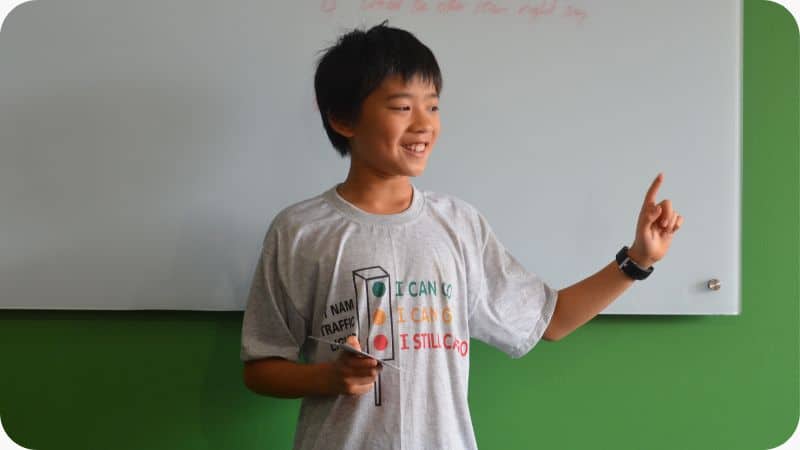
Giving an incredible speech doesn’t just mean delivering great content – it’s also about using the right body language to engage your audience and drive home your point. One important aspect of this is gestures. When your hands are free and placed in front of your chest, they can move naturally to emphasize certain points or ideas. This makes it easier for you to connect and create a more dynamic and engaging presentation.
Additionally, using gestures can help to increase the overall energy level of your speech, making it more powerful and memorable. So next time you’re preparing for a big presentation, don’t forget the importance of using gestures – it could make all the difference in your delivery.
11. End with a strong conclusion
Your conclusion should be just as powerful as your opening.
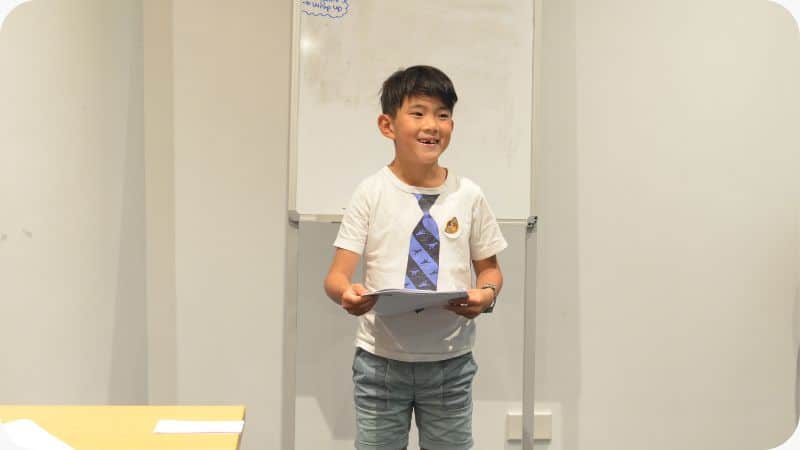
Sum up your main points and leave your audience with something memorable to think about long after you have finished.
By following these tips, you’re sure to give an incredible speech that will wow your audience and leaves them wanting more. So go out there and show them what you’ve got!
Work with an expert – find courses and training for public speaking
Public speaking is a skill that is often overlooked but is crucial in many aspects of life.
From work presentations to career-defining interviews, being able to communicate effectively can make all the difference. While some people are naturally gifted public speakers, most of us could benefit from some training.
Luckily, public speaking courses are widely available, for both adults and kids. By taking a presentation class, you can develop the skills you need to speak with confidence, both generally in life and in competitions. And who knows, you might even enjoy it!
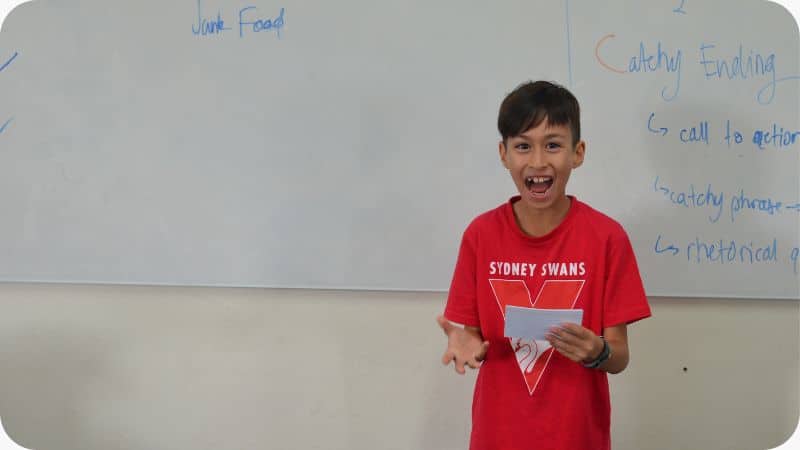
Online training and in-person courses you can join at Speaking Schools Australasia
If you’re interested in finding a public speaking course, Speaking Schools Australasia can help. We offer a range of courses for all levels, from beginners to experienced speakers. Whether you’re looking for online or in-person classes, we can find the right fit for you. And with our convenient course finder, it’s easy to find an online course or a course in your area. So why wait? Improve your public speaking today with Speaking Schools Australasia.
Giving speeches can be nerve-wracking for kids, especially if they are not used to speaking in public. However, with a bit of confidence and some helpful tips, your child can overcome their stage fright and deliver a great speech! In this blog post, we will discuss some tips that will help your child feel more confident when giving speeches. We will also provide a few strategies that they can use to calm their nerves before going on stage.
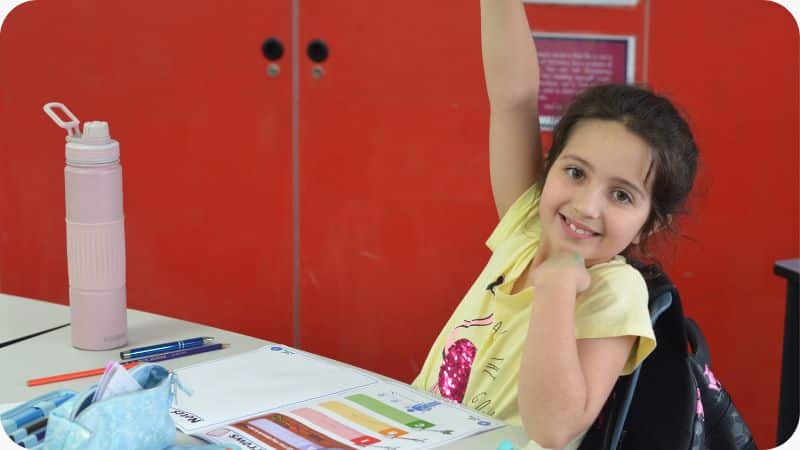
Practise your speech as often as possible
One of the best ways to gain confidence is to practice, practice, practice! If your child can memorise their speech and then practice delivering it in front of you or another family member, they will be more comfortable with the material and less likely to freeze up when they are on stage. You can also help them by providing positive feedback and constructive criticism after each practice session.
You can learn more about the benefits of practising properly in some of our other blogs!
Practise breathing exercises with each run-through
Another way to help your child build confidence with each practice session is to teach them some deep breathing exercises. When we are nervous, our heart rate speeds up and we start to take shallow breaths. This can make us feel even more anxious and contribute to the feeling of stage fright.
By teaching your child some deep breathing exercises, they will be able to slow down their heart rate and take some deep breaths to calm themselves before they start their speech. You can find some examples of different breathing techniques on our YouTube channel!
Nervousness is normal while public speaking
It is important to remind your child that it’s normal to feel anxious when public speaking. Even the most experienced speakers still get butterflies before they give a speech. Remind them that it is normal to feel nervous and that the key is to focus on the material and deliver the speech to the best of their ability.
If you follow these tips, your child will be well on their way to giving a great speech without any stage fright!

Practising alone can be a great starting point
Too shy to practice in front of the family? Why not encourage kids to start by practising in front of the mirror? This way, they can get used to hearing their own voice and seeing themselves speak. Learning the speech and overcoming the fear of public speaking are two separate tasks, and as with all things in life, most people build self-confidence if they have already ticked one thing off the list!
One step better than this might even be speaking to a camera, and watching their speech back. This is a great opportunity for them to catch any mistakes in their speech so that they can fix them before the big day, and to learn how to focus on eye contact without the need to feel embarrassed or the social phobia of looking into an audience member’s eyes while talking.
Now you’re prepared to have people listening
Once your child feels more confident practising their speech in front of the mirror or camera, they’ll be ready to take it up a notch by asking family and friends for feedback. This can be done in person or even over a video call if you have relatives who live far away. Just make sure that the feedback is constructive and positive so that your child feels encouraged.
Choose the right topic
Another great way to help your child beat stage fright is to encourage them to write a speech they are genuinely passionate about. Often they can focus on any topic they are interested in, from their favourite animal to their favourite hobby. If kids are passionate about what they are saying, it will show in their confidence level and delivery. This will also help them to connect with their audience, which is an important part of giving a great speech. You can also learn more about interpreting and selecting topics here.
The purpose of the speech
Speeches can serve a variety of different purposes. It’s important to teach children that their speeches can be written to entertain, persuade, or inform (and many will do a combination of two or even all three!
An entertaining speech is meant to make the audience laugh or smile.
A persuasive speech is one in which the speaker tries to convince the audience to believe or do something.
An informative speech is meant to educate the audience about a certain topic.
You’re not limited to just one of these purposes – often you’ll hear great speeches with all three! Just make sure you are clear about which purposes you intend on taking on, as this will form the basis of your presentation.

Presentations with purpose produce less performance anxiety
Knowing the purpose of the speech is a solid building block for developing the communication skills of adjusting our speaking style to suit what we are talking about.
When we know whether our task is to entertain, persuade, or inform, we often experience a decline in performance anxiety because we know how to approach the task at hand. We don’t need to be funny, persuasive, and informative. We can be whichever of these suits us best and makes us feel the most relaxed – it’s up to the speaker to choose!
Finding the one that best suits your child
Some kids can benefit a lot by changing the purpose of their speech. While some kids love to be informative speakers, others may feel much more confident by presenting a funny speech! Offering them a choice in the matter can also help them to relax and reduce stage fright by allowing them to control the direction of their presentation. This is similar to creative writing, in which children often develop a personal storytelling style that is fun for them and makes them feel inspired.
Selecting the right topic
When deciding on a topic, be sure to choose one that matches the purpose of the speech. For example, if the speech is meant to be entertaining, choose a topic that is light-hearted and funny. If the speech is meant to be persuasive, choose a topic that you are passionate about and that you know will resonate with the audience.
It can be important to consider whether the audience will be of a young age, a broad range of ages, or attending for a specific occasion. Selecting a topic you are confident the crowd will find interesting can boost self-esteem while presenting at school or in class.
What are some speech topic ideas for kids?
- A review of their favourite book
- Why they should get a pet
- How to make their favourite recipe
- The history of their favourite sport
- Their opinion on current events
The sky is the limit when it comes to choosing a topic for kids to write about. Just make sure it is something they are passionate about so that they can deliver a great speech and also have fun whilst public speaking!
Talking about nerves can make all the difference
Another way to help your child overcome their stage fright is to talk to them about what they are feeling. Help them to understand that it is normal to feel some nerves before a big performance, but that there are ways to manage those nerves so they don’t get in the way of a great speech. Encourage them to take some deep breaths and focus on their positive qualities. Remind them that they have worked hard and that you know they can do it!
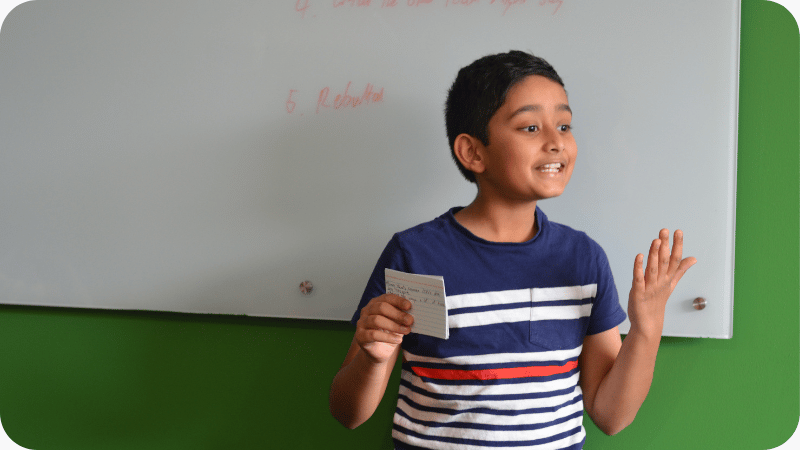
Name and acknowledge feelings to reduce stress and anxiety
It is helpful to give a name to the uneasy feeling or nervous energy you are experiencing. The body naturally goes into a fight or flight response when we feel unsafe or perceive that we are facing a dangerous situation. Breaking down this physiological reaction and understanding that each symptom will pass can be very beneficial.
Visualise with a body scan
Try to visualise the performance anxiety symptoms you are experiencing: tight throat, trembling hands, changes in heart rate, rapid breathing, racing pulse, strained voice, sweaty palms. Rather than trying to control these experiences, just acknowledge them and move on to focusing on other areas of the body. This relaxation technique can reduce public speaking anxiety and help with anxiety in general.
Presentation success can prove our fear was based on a myth all along
There’s nothing wrong with feeling the symptoms of social anxiety or anxiety in general. They are simply feelings that come from our public speaking fears, and will often pass when we discover that the experience didn’t happen the way we expected it to at all.
A lot of the time, the presentation was way more fun and much more of a success than we anticipated, as we tend to engage with overly negative talk to ourselves when facing a scary obstacle.
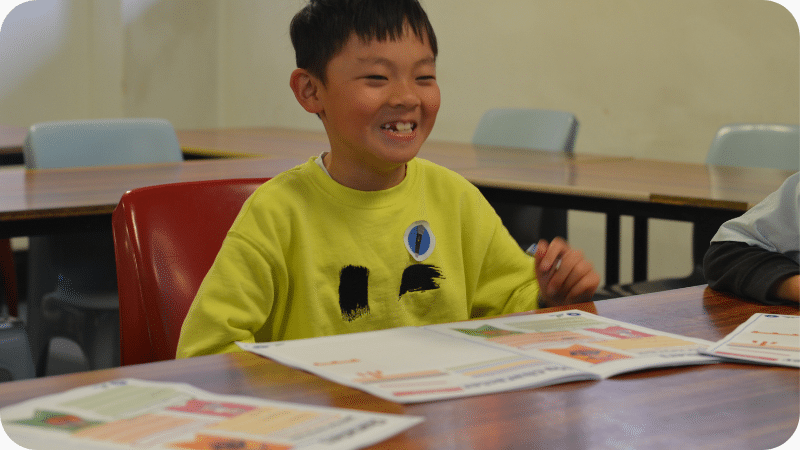
Overcome the fear of public speaking with calming techniques
If your child is still feeling nervous before their big speech, there are a few calming techniques that they can try. One is to take slow, deep breaths through the nose and out through the mouth, like those discussed above. This will help to slow down their heart rate and calm their nerves. Another helpful technique is to visualise themselves giving a great speech. They should picture themselves feeling confident and relaxed on stage, and imagine the audience applauding after they finish speaking. This will help to boost their confidence levels.
Give words of encouragement
Finally, be sure to give your child plenty of support on the day of the big event. Arrive early to cheer them on and offer any last-minute advice. Have a talk to let them know that you are proud of them no matter what happens, and there is no need to have performance anxiety as you will be proud of them for simply having a go. With your love and support, your child can overcome stage fright, self-doubt, and social anxiety to give a great speech!
Having the love and support of one audience member can reduce worry and help children to overcome performance anxiety. Make the experience fun and positive, and they will be more likely to love speaking and want to do it again in the future.
We hope that these tips will help your child overcome their stage fright and deliver a great speech! With a little confidence and some practice, your child can give speeches like a pro! If you have any other tips or suggestions, please feel free to share them in the comments section below. Thank you for reading!
Have you felt nervous when you have given speeches?
Don’t worry, you’re not alone. Many people feel anxious when they have to speak in front of an audience. But don’t let your nerves get the best of you. By following a few simple tips, you can develop your communication skills and deliver a well-crafted speech that will engage and excite your listeners – an incredibly important life skill.
Introductions are Key
When you’re giving a speech, the introduction is key.
How a person starts their speech is important because it’s what grabs the attention of the audience and gets them interested in what they have to say. It’s their opportunity to make a good first impression, so you want to make sure that it’s strong and engaging. This is especially true for children, who given their age often lack the gravitas that is more easily attributed to many adults.
A well-crafted introduction can set the tone for a child’s entire speech, so it’s worth taking the time to get it right. In addition, a good introduction will help keep a child’s audience focused on what they have to say. So if your child is feeling stuck on how to start their next speech, be sure to get them to think hard about their introduction, both in terms of the words they’re going to use and the manner in which they want to present it. With a little practice, they will be able to craft an intro that leaves a lasting impression on their audience!
In this blog we’re going to explore five ways a child might want to start their speech, as well as a range of other public speaking tips to help kids get the most out of their speeches:
- How to use a personal anecdote to engage your listeners
- The best way to use rhetoric to hook your audience
- Whether bold statements, startling statistics, or famous quotes add up to a good speech introduction
- How keeping it simple, following a structure, and building up confidence can help children prepare a killer intro
If you or your child wants to learn more about introductions or other public speaking tips for everything from body language to visual aids, check out our YouTube channel for plenty of ideas on how to help your child prepare their next speech!
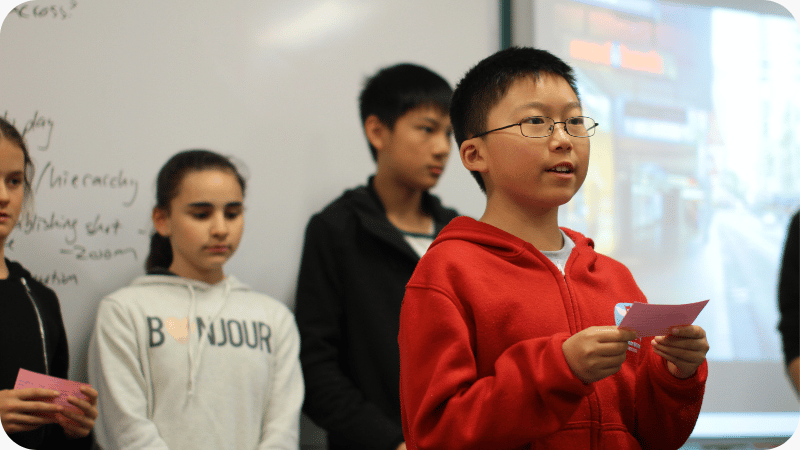
Starting with a personal story to engage your audience members
One way a child can easily engage their audience members from the start is to share a personal anecdote relevant to their topic. This can help listeners connect with the child on a personal level and make them more interested in what they have to say.
For example, if your child was giving a speech about the importance of education, they could share a story about a time they struggled when they were younger and how working hard helped them turn things around. Or, if they were speaking to other students about the importance of being kind to others, they could share an anecdote about a time when someone was kind to them and how this made them feel.
By sharing a personal story, any child can help their audience see them as a real person and not just some abstract figure who is talking at them. As a result, they will be more likely to engage with what the speaker is saying and remember it long after the speech is over.
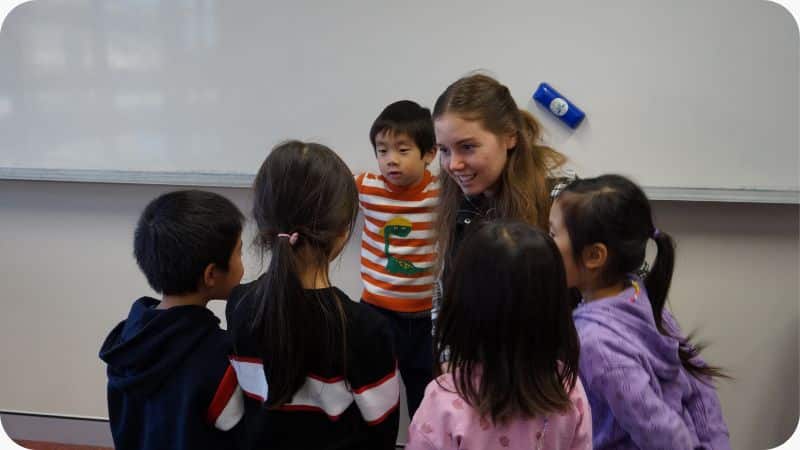
Using rhetoric to your to grab your audience’s attention
Another effective opening a child can use to open their speech is to pose a rhetorical question to their audience. This will get listeners thinking about the answer to their question and make them eager to hear what they have to say next.
This is an especially effective way to open speeches, as it helps to set the stage for what you’ll be discussing in a way that piques the interest of your audience. People (and especially kids) are naturally curious – if you’ve got an interesting take on the question, or chose to start your speech with a question the audience is interested in but don’t know the answer to, you’re much more likely to hook them in and leave them keen for what comes next.
For example, if a child was introducing a speech on public speaking, they could ask the audience “How many of you have ever had to give a speech in front of a large group of people?” This question will get people engaged and thinking about their own experiences with public speaking.
It is important to remember that an opening line will only be effective if the speaker pauses, looks up from their palm cards and make eye contact with their audience – this gives them time to consider what the speaker has said and relate to the key points they hoped the audience would take away. It is important to keep this in mind whenever you practice your speech as well!

Bold statements, statistics and quotes
There are plenty of other ways that you might want to open your speech, and whilst these may work for some kids, you should be wary that they’re used properly.
Bold Statements…
One way might be to make a bold statement about your topic in your introduction, potentially explaining an extraordinary scenario to your listeners. This can help listeners understand the main point of your speech and get them interested in hearing more.
…Startling Statistics…
Another could be to start with a startling statistic or fact related to your topic. This can immediately grab the attention of your listeners and set the stage for the rest of your speech.
…and Famous Quotes…
The final way children might be able to open a speech is by referencing a famous quote that is relevant to their topic. This will show that you are knowledgeable about the subject and will get listeners thinking about the implications of the quote in relation to your topic.
…often aren’t the most exciting openers
That said, for most people all three of these are generally less effective than personal anecdotes or rhetorical questions. If you’re going to go down this route, make sure that your statement is truly bold, your statistic is interesting and relevant, or your quote is well-chosen. Otherwise, the message you’re trying to convey can easily be lost, and your introduction can become substantially less impactful.

Public speaking tips to improve my child’s speech introduction
Whilst an introduction isn’t your whole speech, it is one of the most essential parts of crafting an engaging presentation. Below are some tips for helping your child develop a great speech.
Keep the Message Simple
Firstly, when writing the body of the presentation, make sure to focus on a single idea (rather than a range of possible topics) and keep the message simple – rather than attempting to conquer the world, a strong speech will usually focus on a core thesis, with a key point (including up to three of these can work well) to back it up. It is important to write speeches with this in mind, as it allows public speakers to prepare a concise and easy-to-follow introduction, helping their audience focus on what’s important.
Looking for ideas on how to pick the right message? Check out our blogs on picking the perfect speech topic and 101 incredible public speaking topics to see how to use your passion to make your next presentation even more engaging!
Follow a Coherent Structure
Secondly, make sure that the introduction follows a coherent structure that feels comfortable. Start with one of the hooks we discussed above – it’s important that your child’s speech grabs the audience’s attention. Move on from here to actually address the audience – whether this be a “good morning” or a simple “hi there” – and introduce the key subject you’ll be speaking about. Finally, an introduction will usually flag the ‘matter’ of your speech – the main arguments you’re going to speak about. Using a structure like this can help kids feel more comfortable and aid them in keeping on message when they present.
Interested in learning more about how to structure a presentation? Have a look at our blog on how to structure a speech to learn more!
Build Up Confidence in Advance
Finally, make sure to build up your child’s confidence in advance. This is something that many children have difficulty with – once they have written their speech, make sure that:
- you talk to them about what they wanted to achieve with their speech, help them find the best words to do so, and answer any questions they might have;
- the speech has been written as dot points on palm cards, so they can practice properly and aren’t able to read the speech word for word;
- if your child is nervous, you speak with them about how they can use deep breaths before they talk to help dispel the nerves and ensure they are able to stay on message;
- if they’re up to it, you look at the presentation skills your child is using, and match things like gestures and facial expressions to the words they’re using, ensuring they are getting their point across in the most persuasive way possible – practice makes perfect; and
- they practice, practice, and practice again: you will want to give them lots of opportunities to deliver their speech, whether it be to friends, family members, or other adults – the idea is to not only practice their speech, but also to ensure it sticks to the time limit and provide feedback to your child, and to reinforce that it is an engaging speech, as this will give them to confidence to deliver an even better presentation when they stand in front of a proper room.
The more confident children feel about their speech, the more comfortable they will feel when they stand in front of their audience and start speaking. Every child must find their voice before they enter the room to ensure they’re ready to begin as soon as they step in front of their audience. This starts with family at home, and over time can build up to larger groups and have wide-reaching implications for any child’s life.

Want to learn more about the benefits of developing public speaking and debating skills? Check out our blog to find out how your child could benefit!
The key ideas for how to start a speech for kids
When it comes to giving a speech (and public speaking more generally), you need to grab the attention of your audience and give them a taste of what’s to come.
But how can children make sure their introductions are up to scratch?
The main things to remember are:
- Hook the audience with a catchy opening like an anecdote or rhetorical question
- Make sure the speech (and introduction) focuses on one central message
- Have a clear structure
- Practice your introduction multiple times
- Build up confidence in advance
It’s important to give your child the best chance for success when it comes to public speaking and developing communication skills. This means teaching them how to write and deliver a good introduction. By following these simple tips, you can help them make a great first impression that will get their audience hooked.
If you’re looking for more advice on this topic or want to help your child build up their confidence in advance, check out some of our other blogs, head to our YouTube, or enrol them in one of our public speaking or debating courses today. We’ll provide everything they need to nail their next speech!